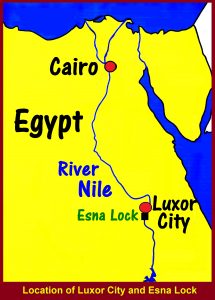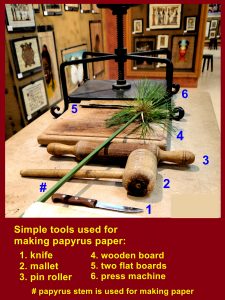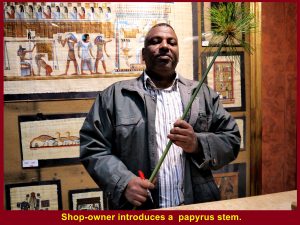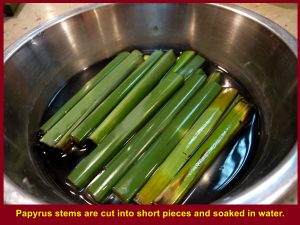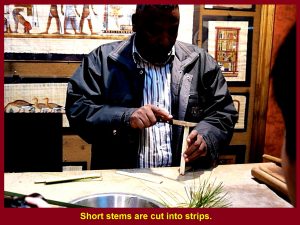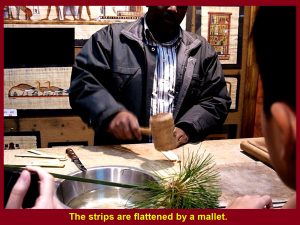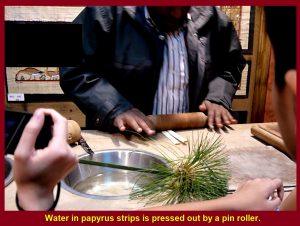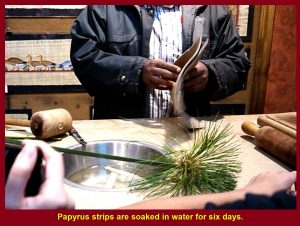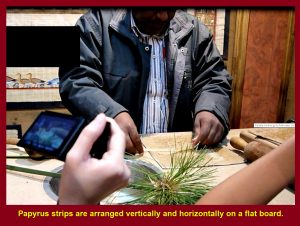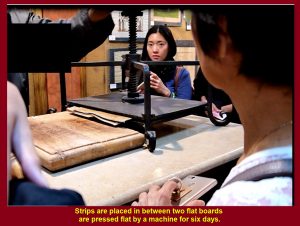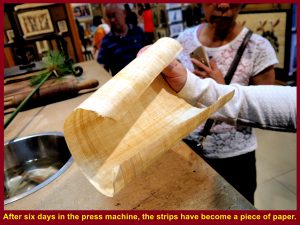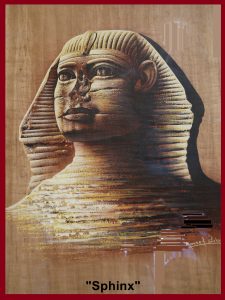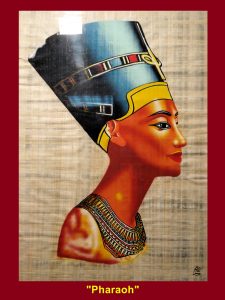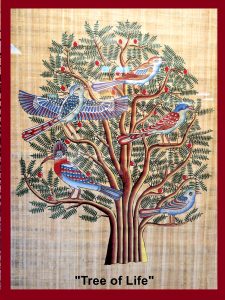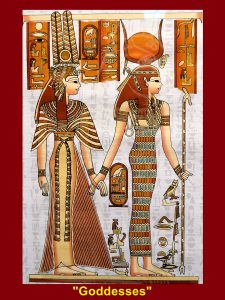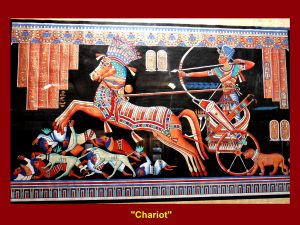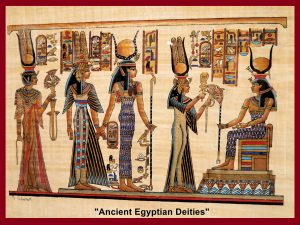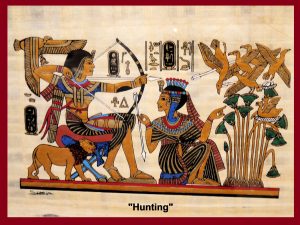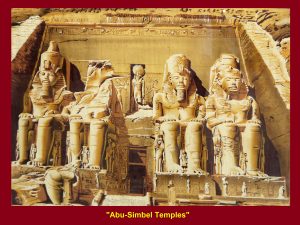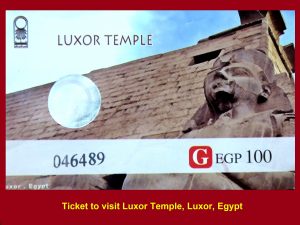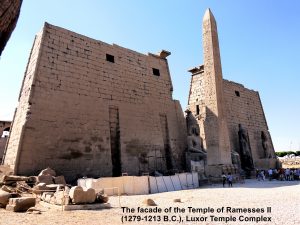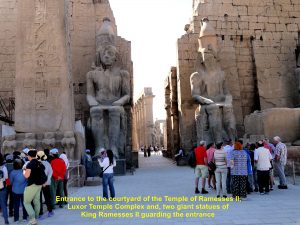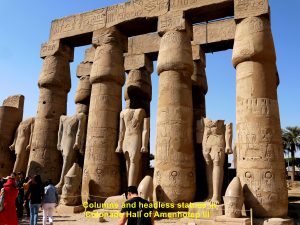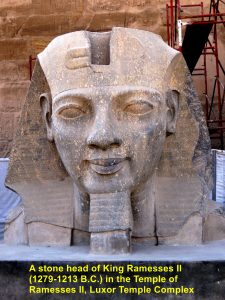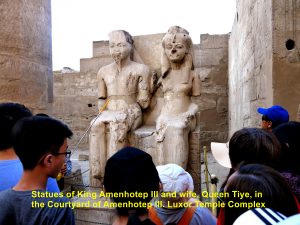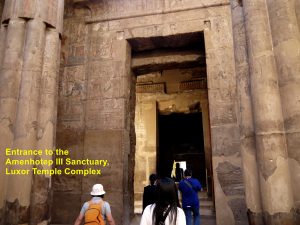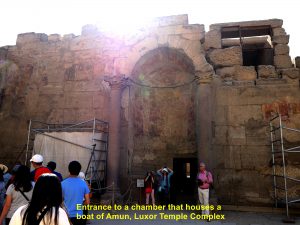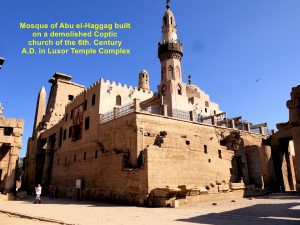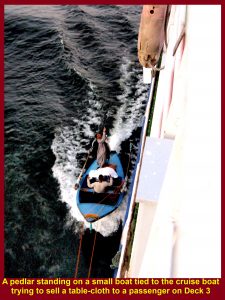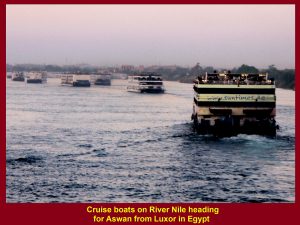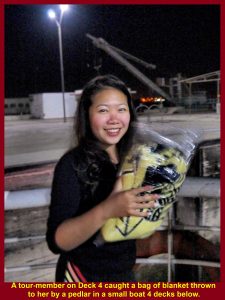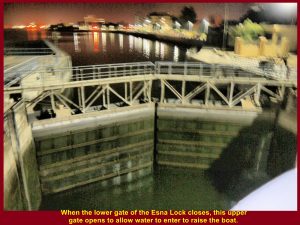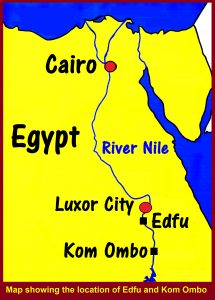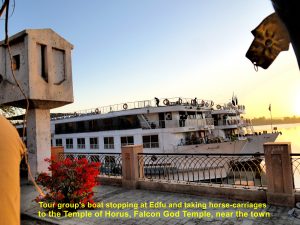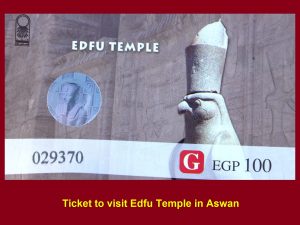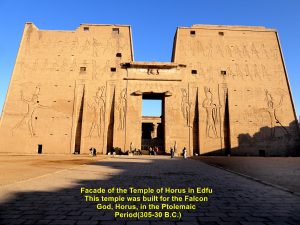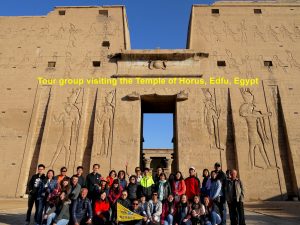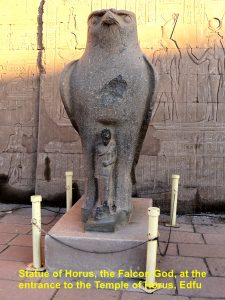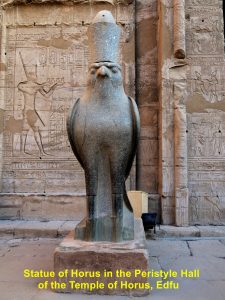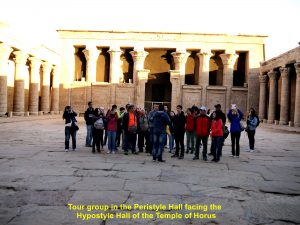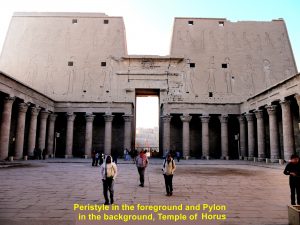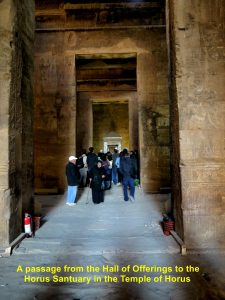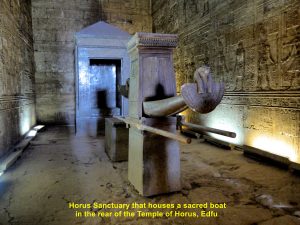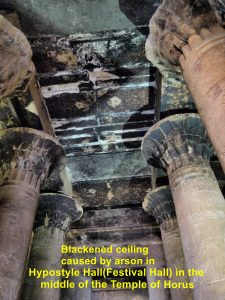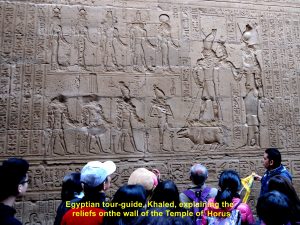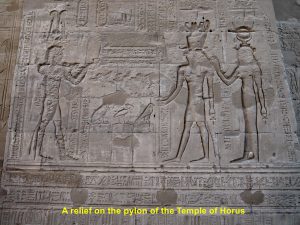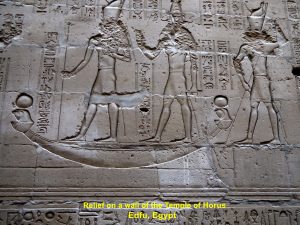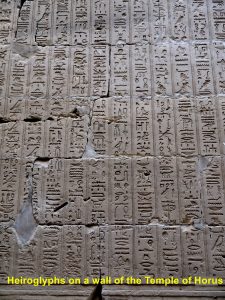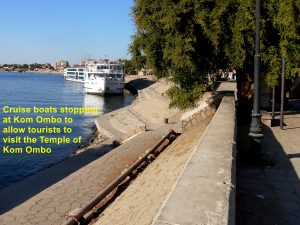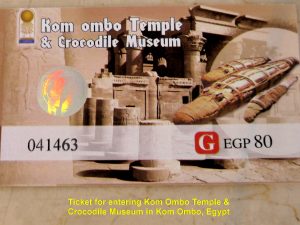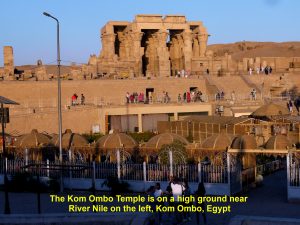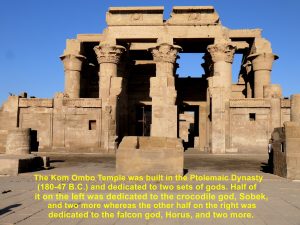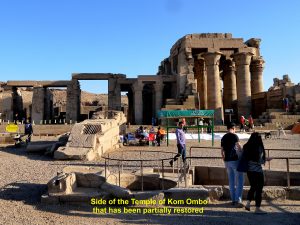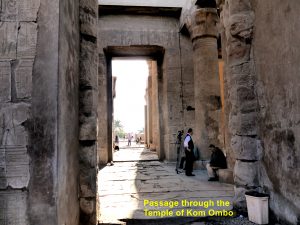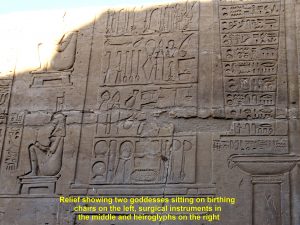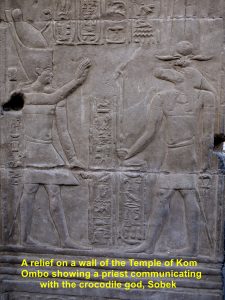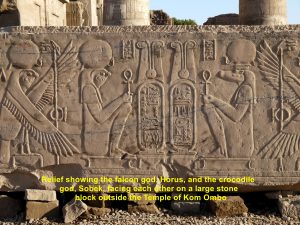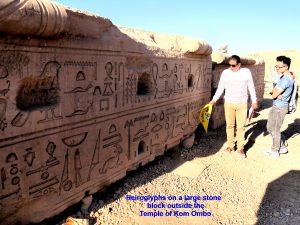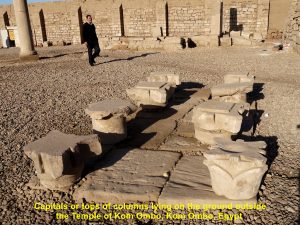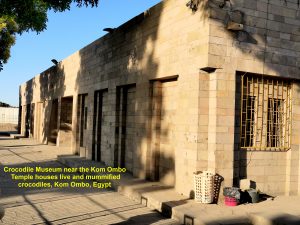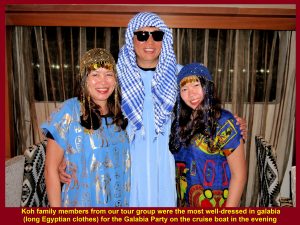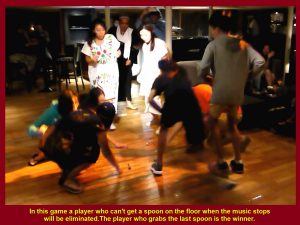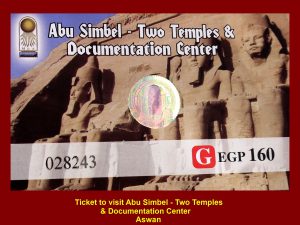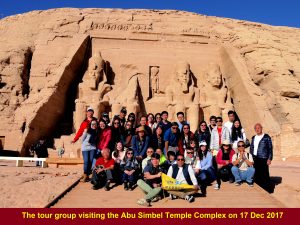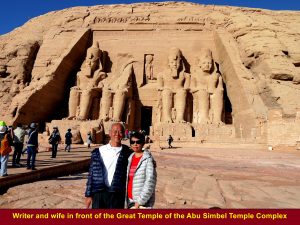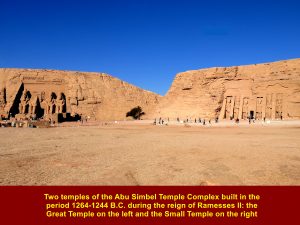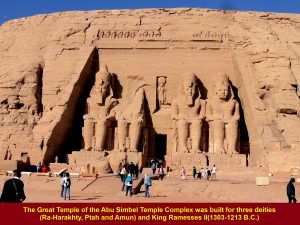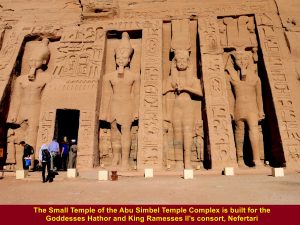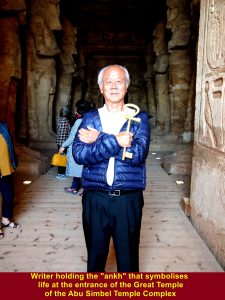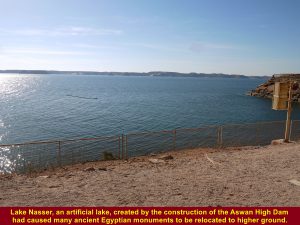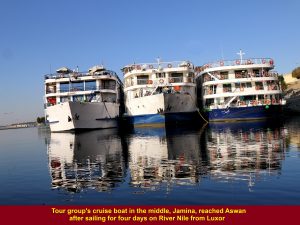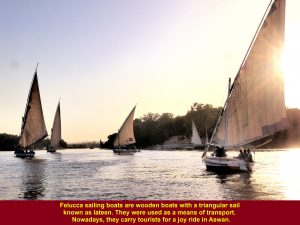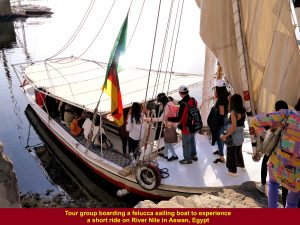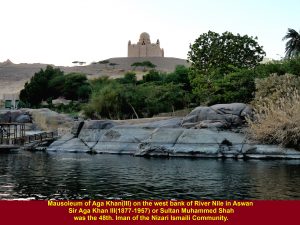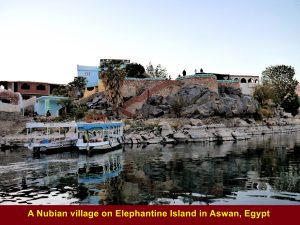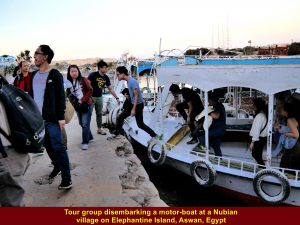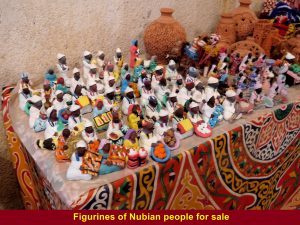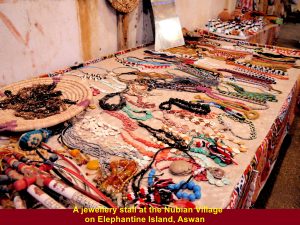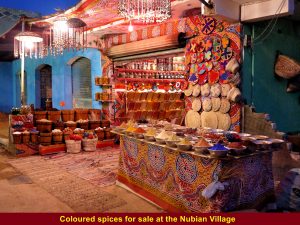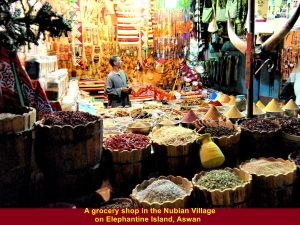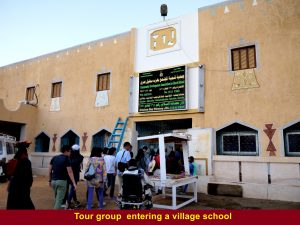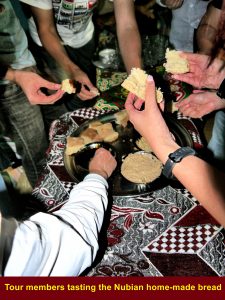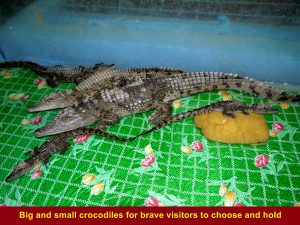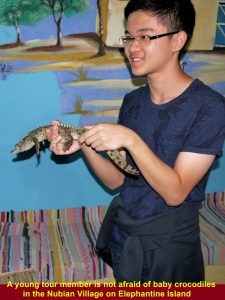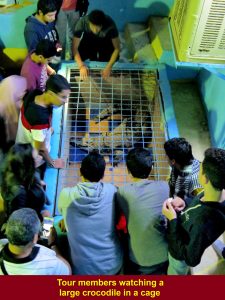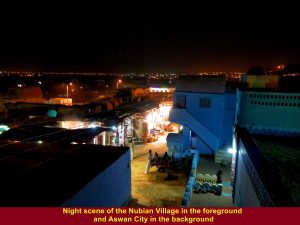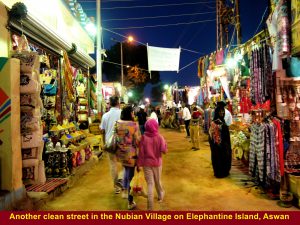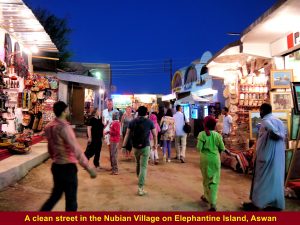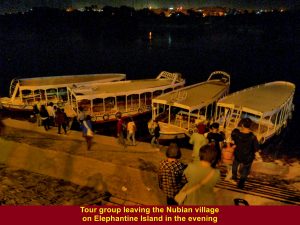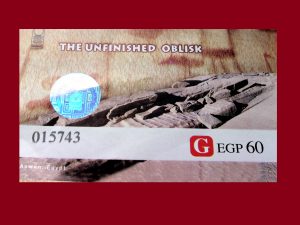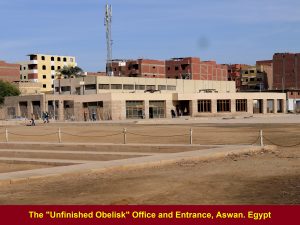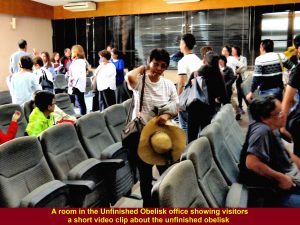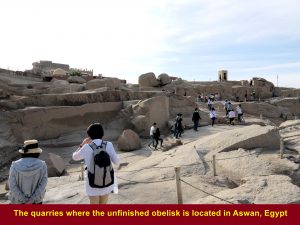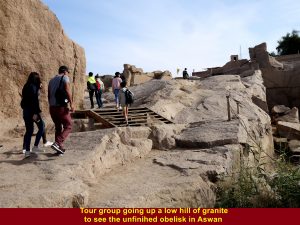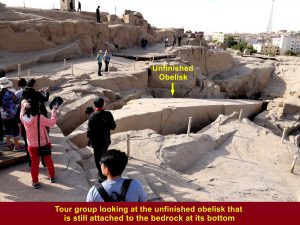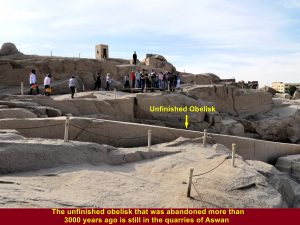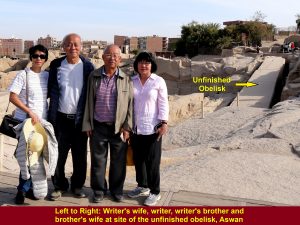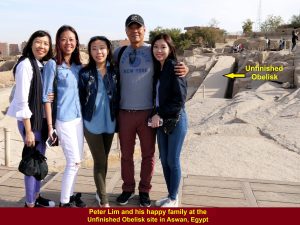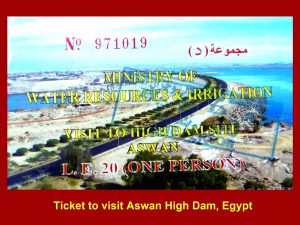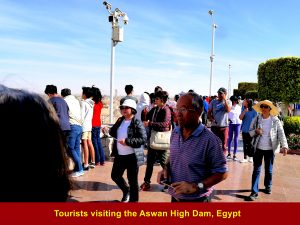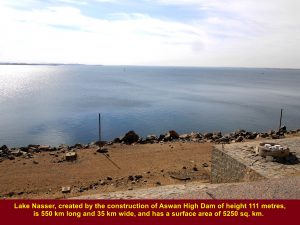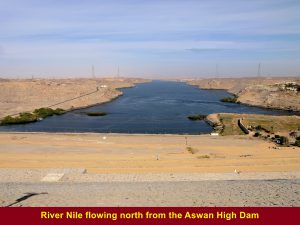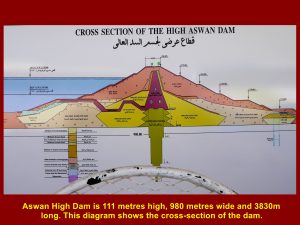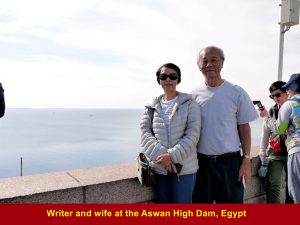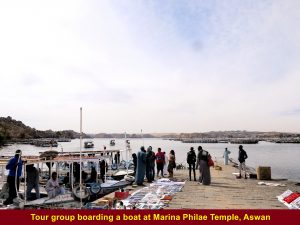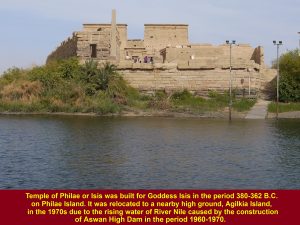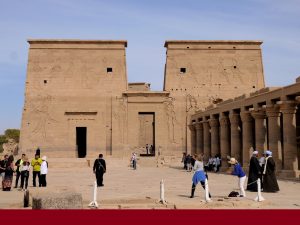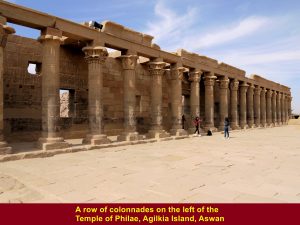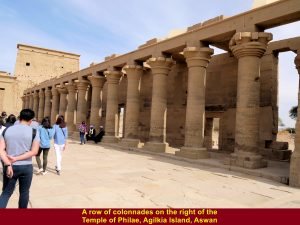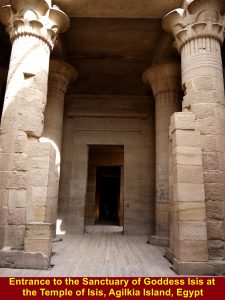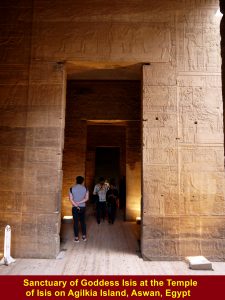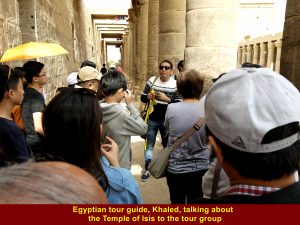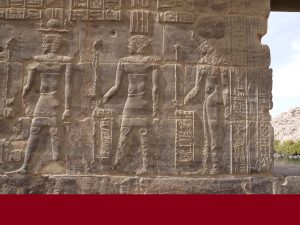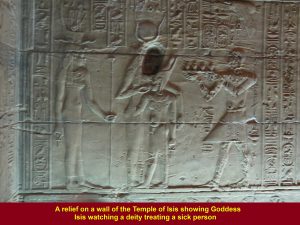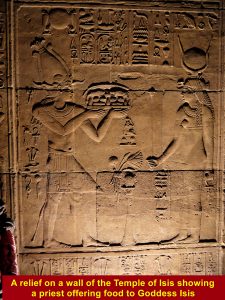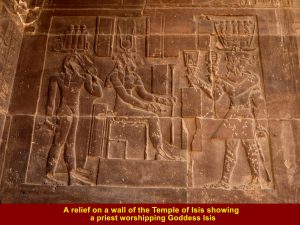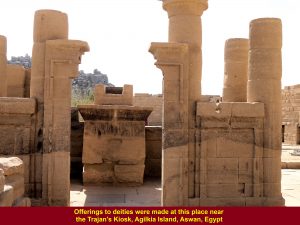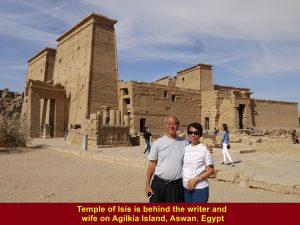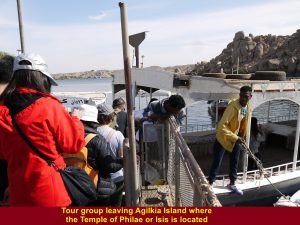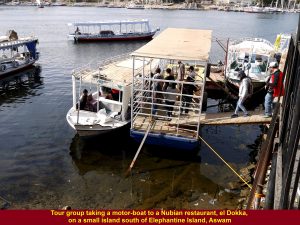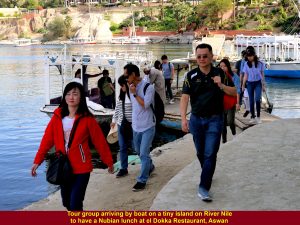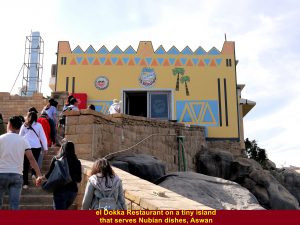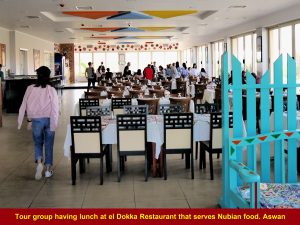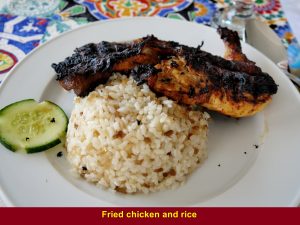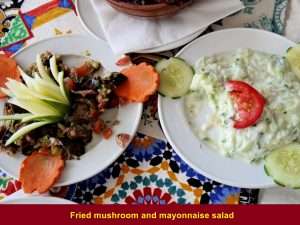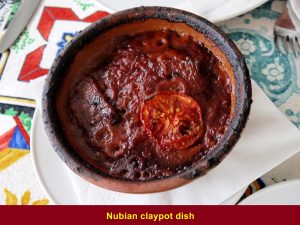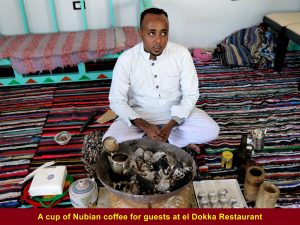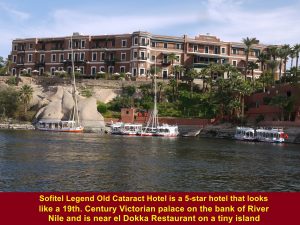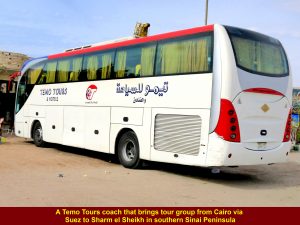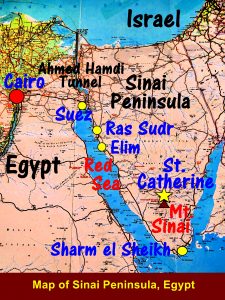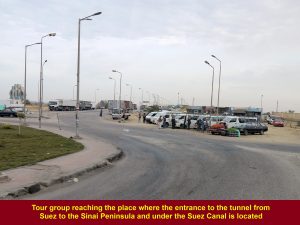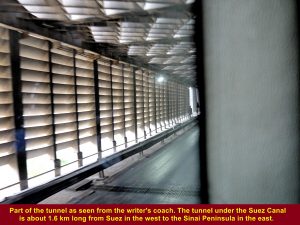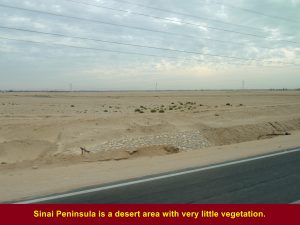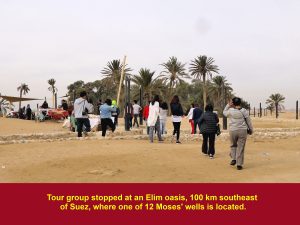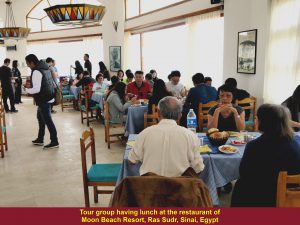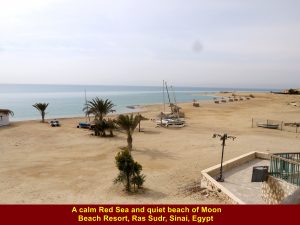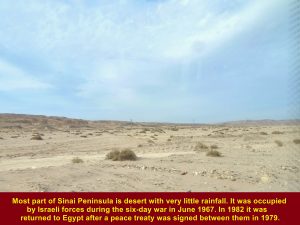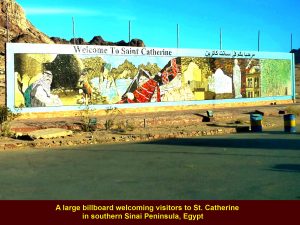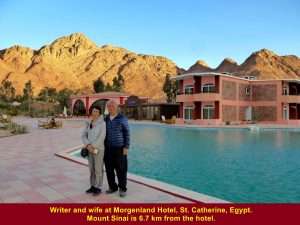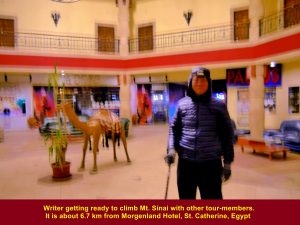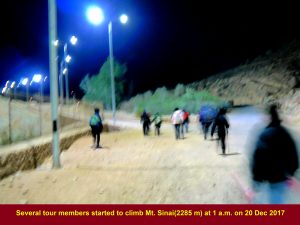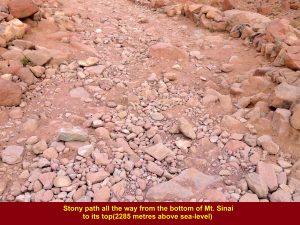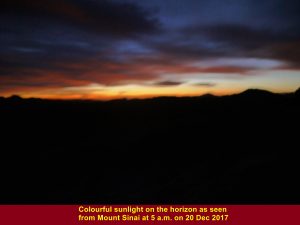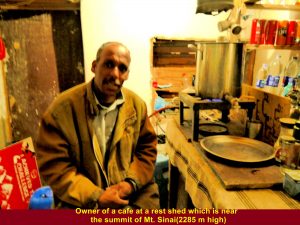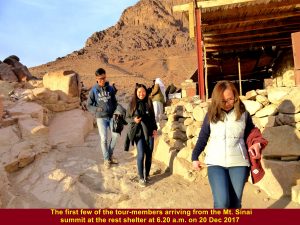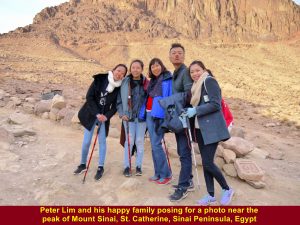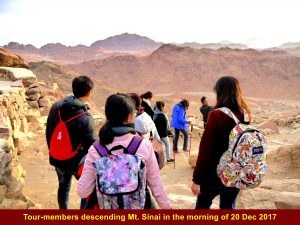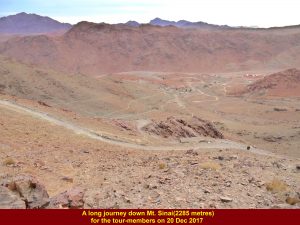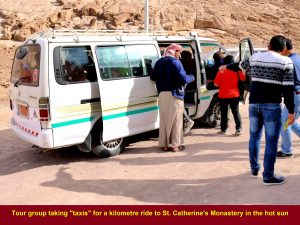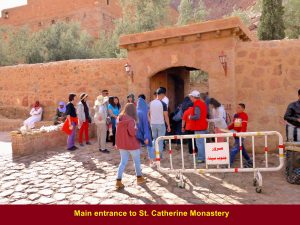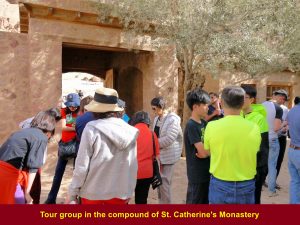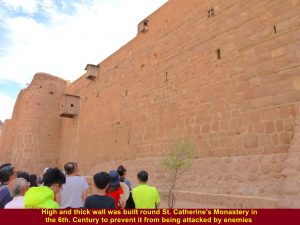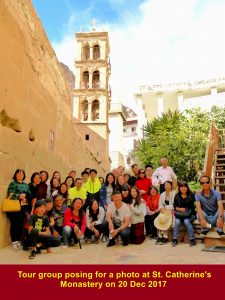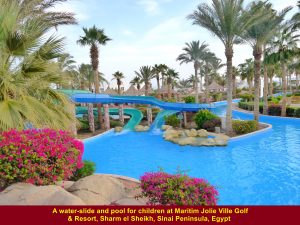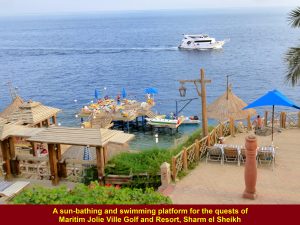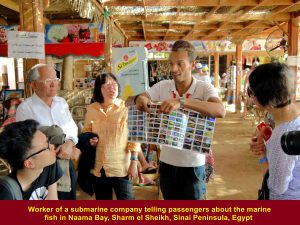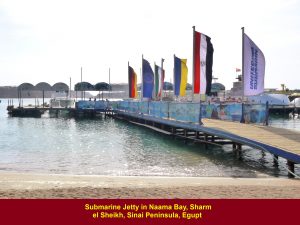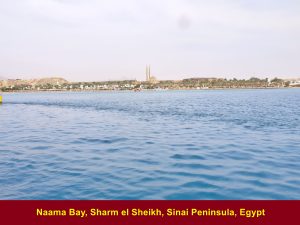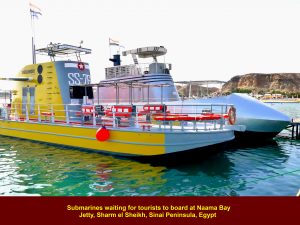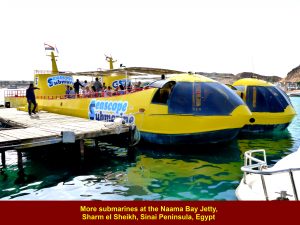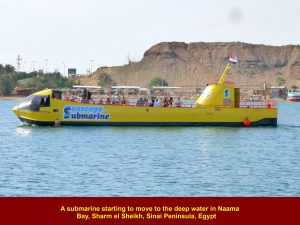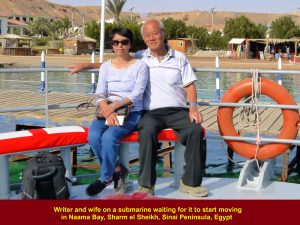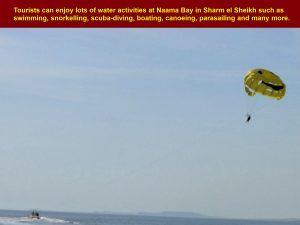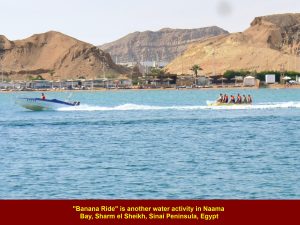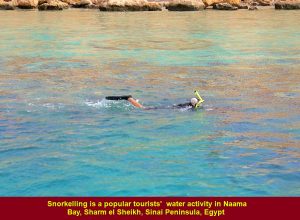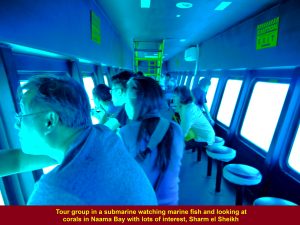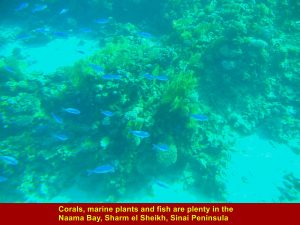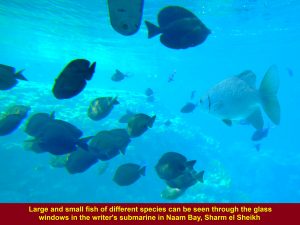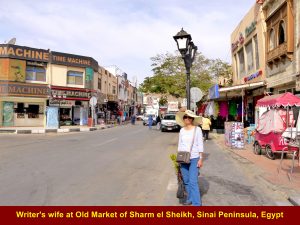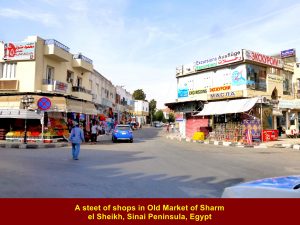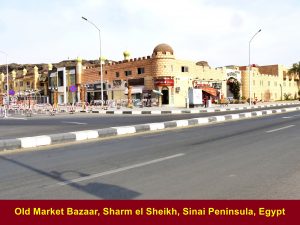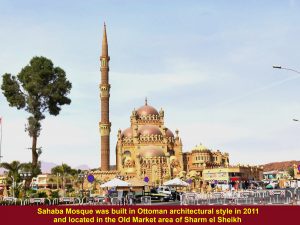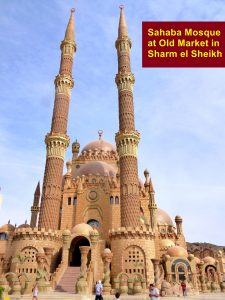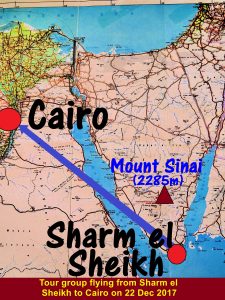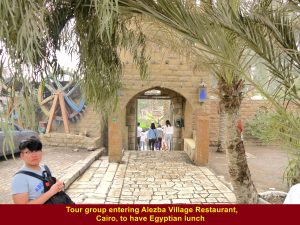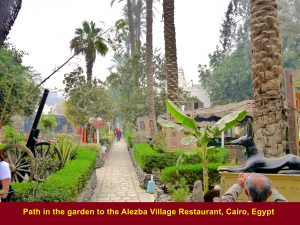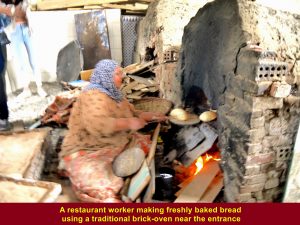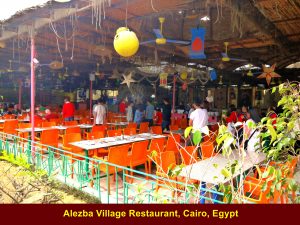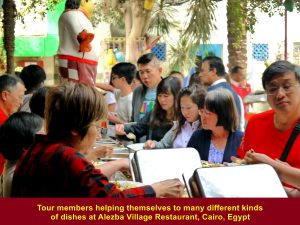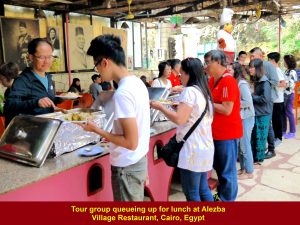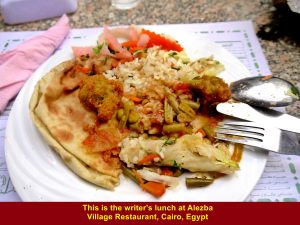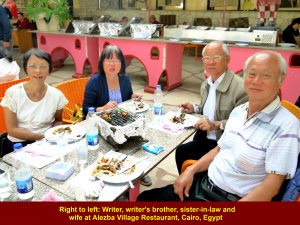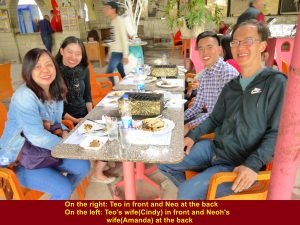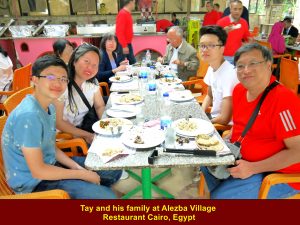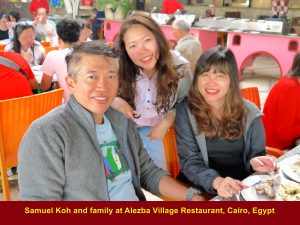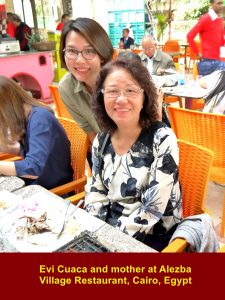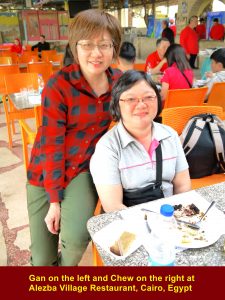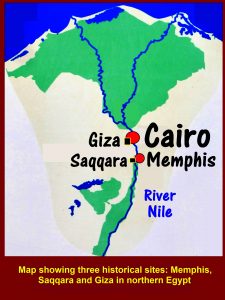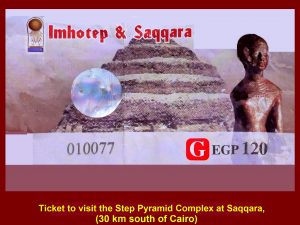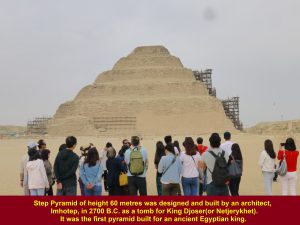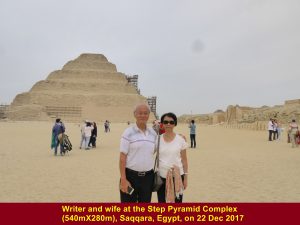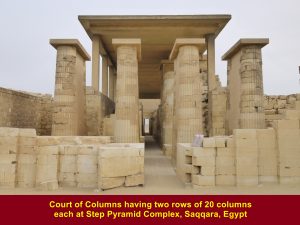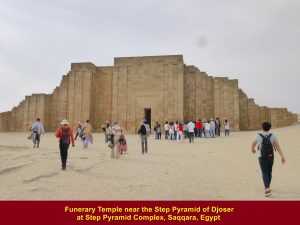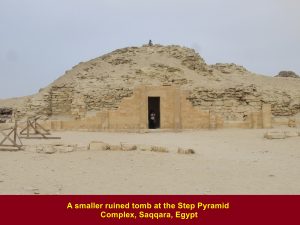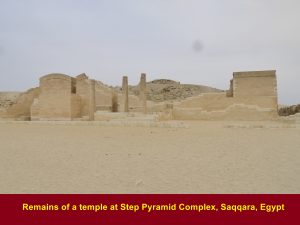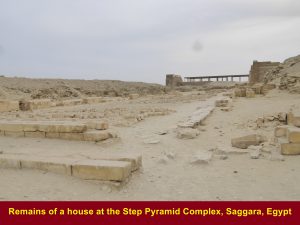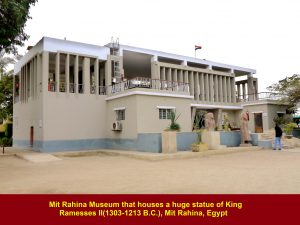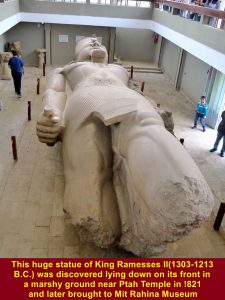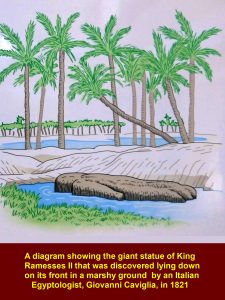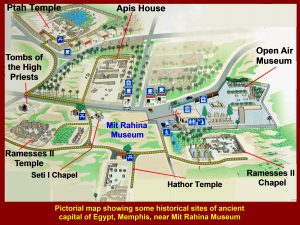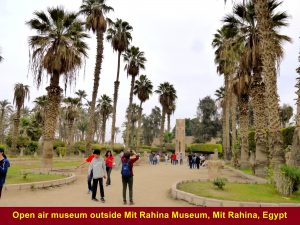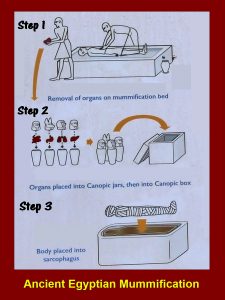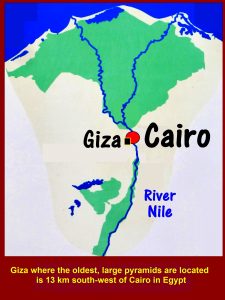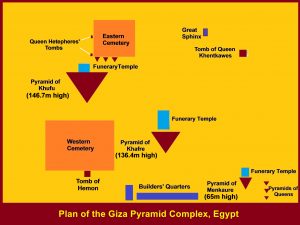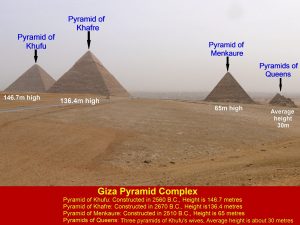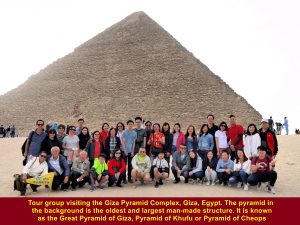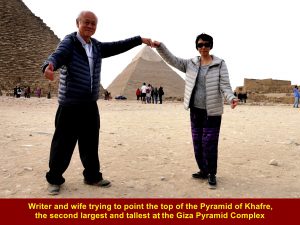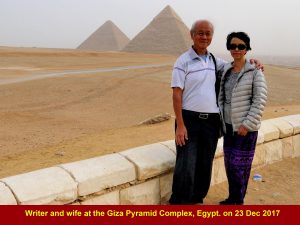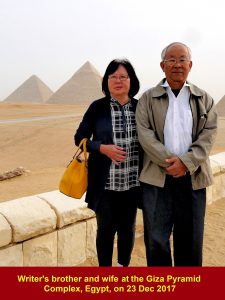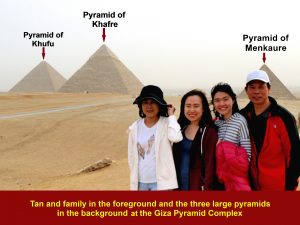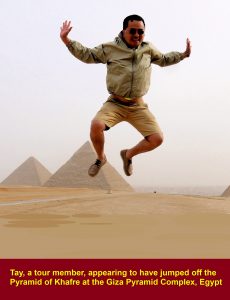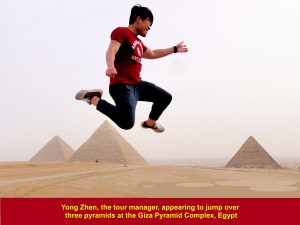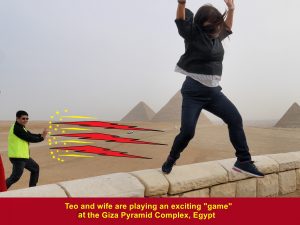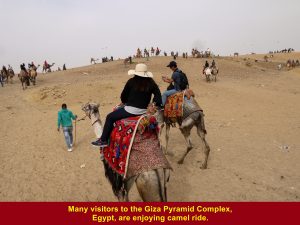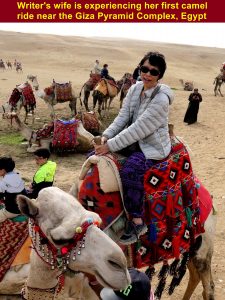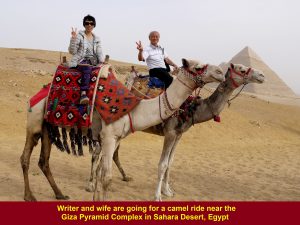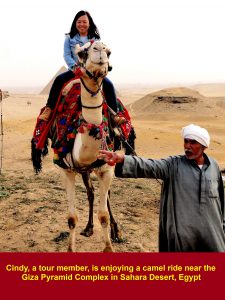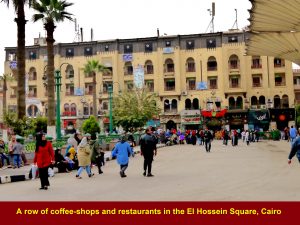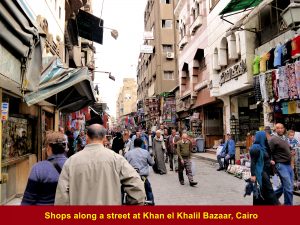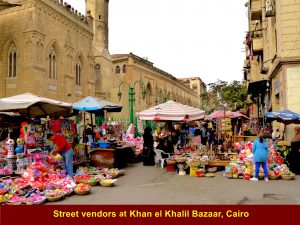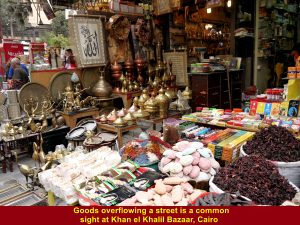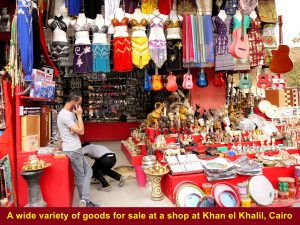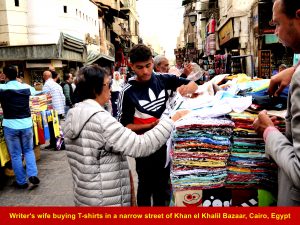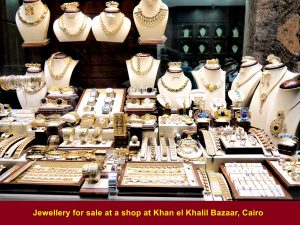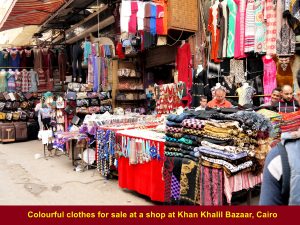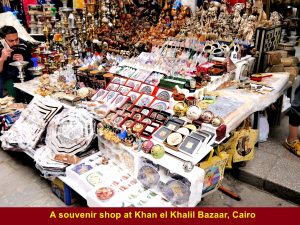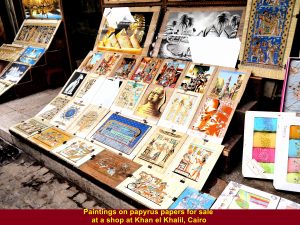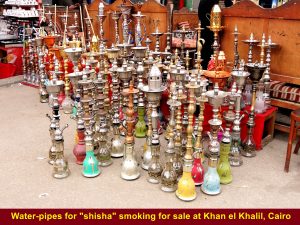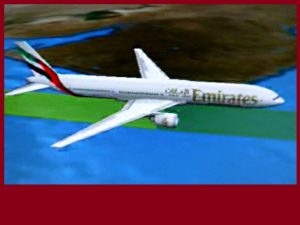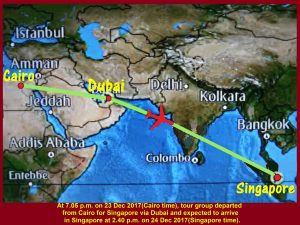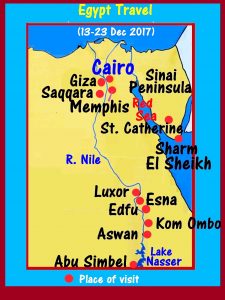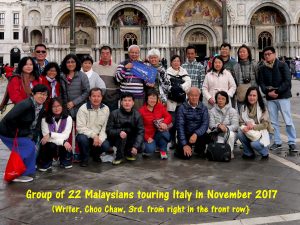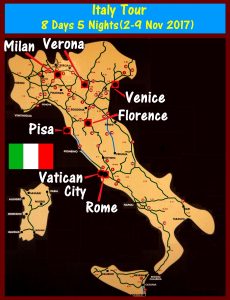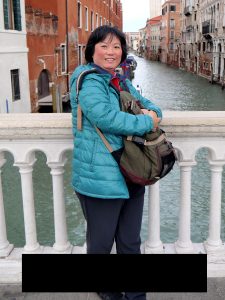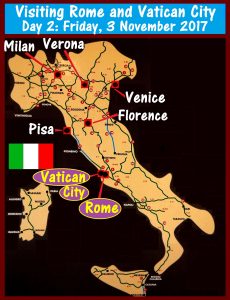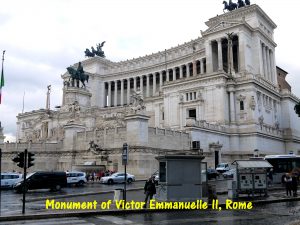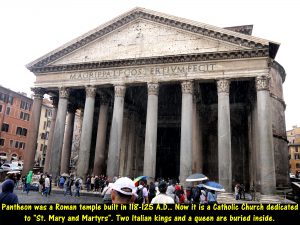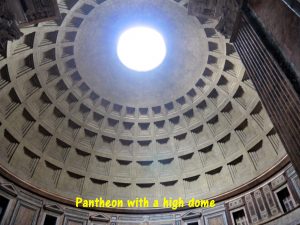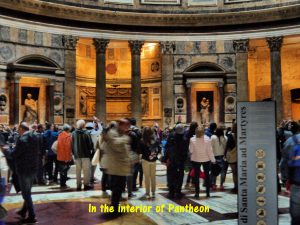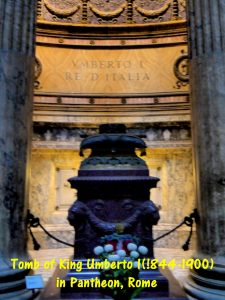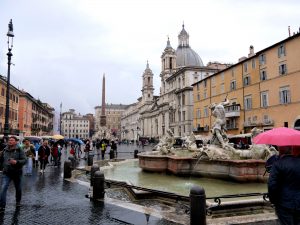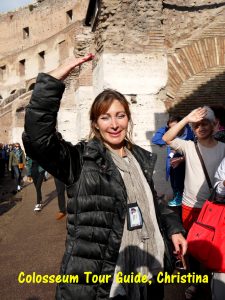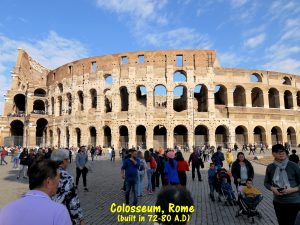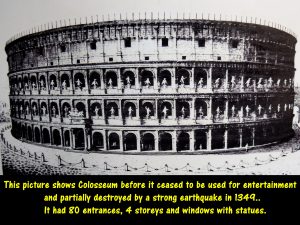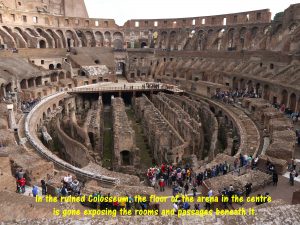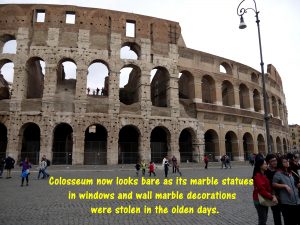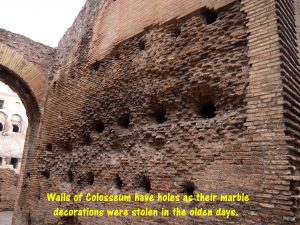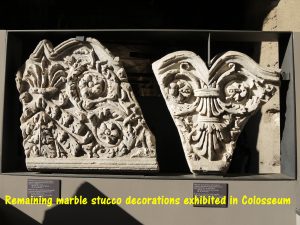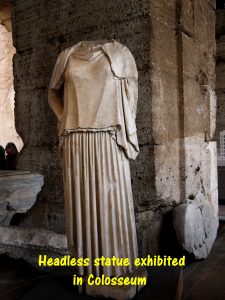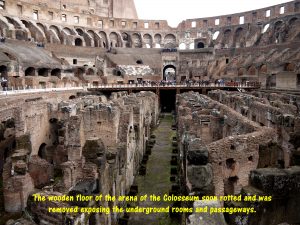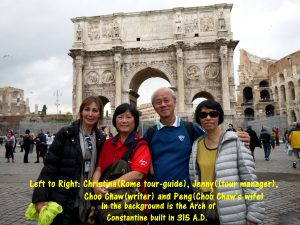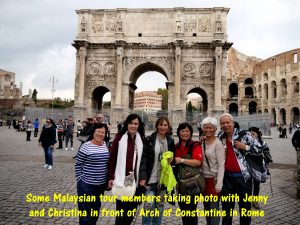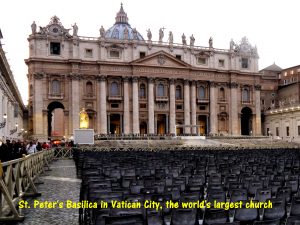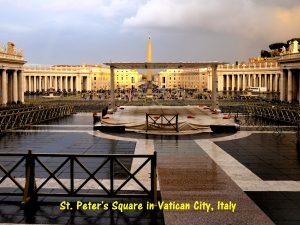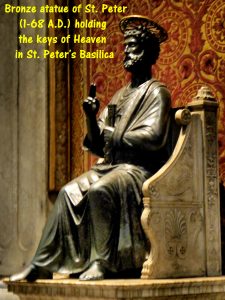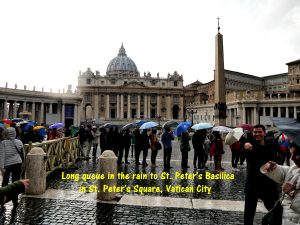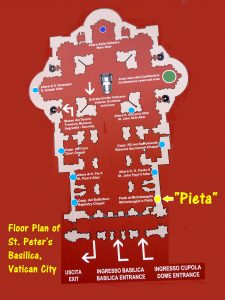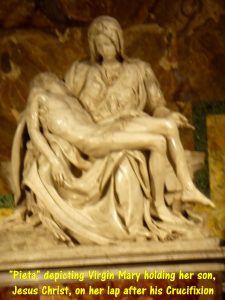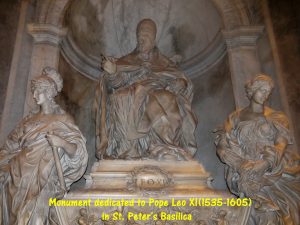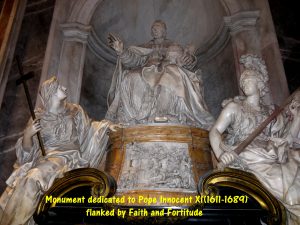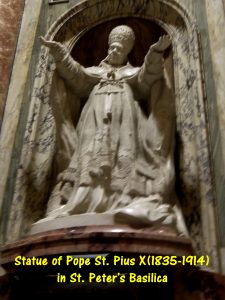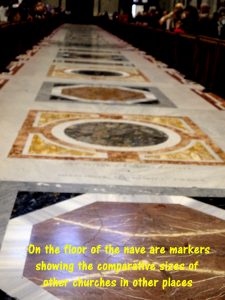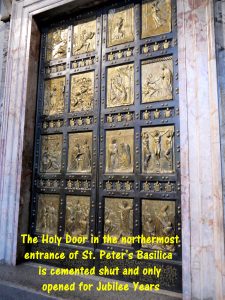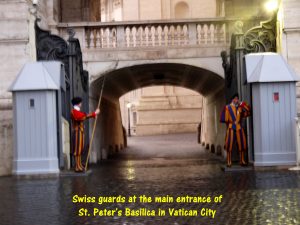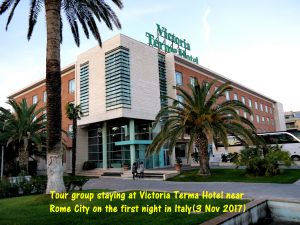Egypt Travel IV: Papyrus Paper Making, Luxor Temple Complex and Esna Lock
Egypt Travel IV: Papyrus Paper Making, Luxor Temple Complex and Esna Lock
Papyrus Paper-Making Lesson at Sondos Papyrus Shop in Luxor
After seeing the Karnak Temple Complex we visited a shop in Luxor City that was selling paintings on papyrus papers. It was called Sondos Papyrus.
When we entered the shop we were given a lesson on papyrus paper making by the owner. He showed us the method of doing it using simple tools as shown in the photos below.
Simple Tools for Papyrus Paper-Making
First he showed us papyrus stems.
The stems were cut into short pieces and soaked in a bowl of a dark liquid.
Then he cut the stems into thin strips.
The strips were flattened by a mallet.
He used a pin-roller to squeeze out the water in the flattened strips.
Next, he said that the strips had to be soaked in water for six days to make them soft.
Arrangement of Papyrus Strips
He took out some papyrus strips that had already soaked for six days and arranged them vertically and horizontally on a flat sheet of rubber until they looked like a piece of paper.
Pressing Machine
He put the arranged strips in a machine and pressed out the water. He said that they would be left inside for six days when they would become a piece of paper.
Papyrus Paper
The gentleman took out a readily made papyrus paper and said that the strips would look like that piece of paper after six days
Writing and Painting
The papyrus paper can be used for writing and painting. It was used by ancient Egyptian rulers.
Below are some of the paintings drawn on papyrus papers which were displayed in the shop and for sale.
“Sphinx”
“Pharaoh”
“Tree of Life”
“Goddesses”
“Chariot”
“Ancient Egyptian Deities”
“Hunting”
“Abu-Simbel Temples”
Visiting Luxor Temple Complex
Having spent an hour at Sondos Papyrus shop, we went to a historical site near Luxor City and it is known as Luxor Temple Complex.
Luxor Temple Complex
Luxor Temple Complex was built by two kings, Ramessess II(1290-1224 B.C.) and Amenhotep III(1391-1353 B.C.). Later, the Roman Emperor, Diocletlan(244-312 A.D.), built a fortress round it in the late 3rd. Century A.D.. Then churches were built at the Luxor Temple Complex.
Ticket to enter the Luxor Temple Complex
Temple of Ramesses II
The Temple of Ramesses II was one of the temple we visited at the Luxor Temple Complex.
Below are some photos showing parts of the Temple of Ramesses II
Facade or Pylon of the Temple of Ramesses II(1279-1213 B.C.)
Entrance to the Temple of Ramesses II flanked by the statues of Ramesses II at the Lixor Temple Complex
Obelisk of King Ramesses II(1279-1213)
There were actually two obelisks of King Ramesses II at the temple entrance. But only one is left and the other is kept in Paris, France.
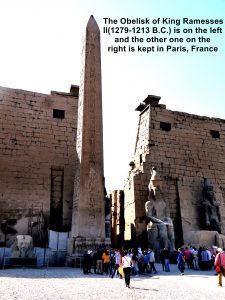
The Obelisk of Ramesses II on the left and the missing one on the right(now in Paris, France) at the entrance of the Temple of Ramesses II
Courtyard in the foreground and Tripartite Shrine in the background of the Temple of Ramesses II
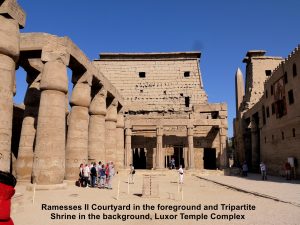
Courtyard of Ramesses II in the foreground and the Tripartite Shrine in the background in the Temple of Ramesses II
Colonnade Hall of Amenhotep III(Reign:1391-1353 B.C.) and Tutankhamun(Reign:1332-1323 B.C.)
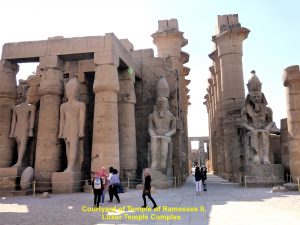
Courtyard of Ramesses II in the foreground and Colonnade Hall of Amenhotep III and Tutankhamun in the background
Columns and Statues in the Courtyard of Amenhotep III, LuxorTemple Complex
Stone Head of Ramesses II in the Temple of Ramesses II, Luxor Temple Complex
Statues of King Amenhotep and his wife, Tiye
Entrance to the Amenhotep III Sanctuary
Amun’s or Sun God’s Boat
Mosque of Abu el-Haggag
There is a mosque in the compound of Ramesses II Temple at the Luxor Temple Complex. Known as Abu el-Haggag, it was built on a ruined Coptic church of the 6th. Century A.D..
50000 Stone Blocks
There are over 500 000 stone blocks outside the temple of Ramesses II which are from the walls of the ruined Temple of Ramesses II and other temples too.
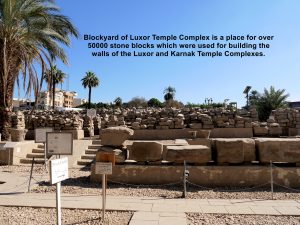
Blockyard of Luxor Temple Complex has a collection of over 50000 stones that are from the walls of the ruined temples at the Luxor Temple Complex
Sailing to Edfu
In the evening we left Luxor City and went back to our cruise boat on River Nile. Soon our boat set sail for Edfu which is 60 km south of Luxor.
River Nile Pedlars
On the way, we saw some pedlars on their small boats tied to our moving large boat trying to sell their textile products to the passengers.
I was fascinated by the way those pedlars doing their sales.
Pedlar’s Sale-Method
A pedlar will call passengers on a cruise boat, loudly. If he spots one looking down at him, he will strike a friendly conversation with him/her and then show his product. Before the passenger can give him a positive or negative answer, the latter throws his product in a waterproof plastic bag to him/her with accuracy. He will ask the person to have a look at the product, put the money in the same bag and throw it back to him if the price is acceptable to the passenger. Otherwise, he has to throw the product back to the pedlar.
Cruise boats sailing on River Nile from Luxor to Aswan
Esna Lock
To go to Edfu from Luxor our cruise boat had go through a lock at Esna in order to get to the higher water level of River Nile.
Esna Lock Pedlars
At the Esna Lock, pedlars in small boats tried to sell their goods to us. We were amazed that they could throw their goods to us while we were on the top deck of our boat which was about 13 metres above the water level!
Two Pedlars in Esna Lock with their goods
A tour-member caught a pedlar’s product but she threw it back to him as she did not need it.
Lower and Upper Gates of Locks
The Esna Lock allows two cruise boats to enter at a time. The photos below show the working of the lock.
Opening of Lower Gate
The lower gate opens, slowly, and the water flows out.

The lower gate of the Esna Lock opens slowly to allow the cruise boat to enter.
Lower Gate Opening Wide
When the lower gate is wide, the boat enters the lock.
Cruise Boat entering the Esna Lock
The boat enters the lock, slowly.
Opening of Upper Gate
When the boat is inside the lock, the lower gate closes. Then the upper gate opens to allow water to flow into the lock raising the boat.
Boat Exiting Lock
When the water level inside the lock is the same as the outside, the boat sails out of the lock and continues its journey to the south.
Two boats are allowed to enter the lock at a time
40 Minutes in the Lock
A cruise boat will take about 40 minutes to pass through the Esna Lock.
After passing through the lock, our boat continued the journey to Edfu in the south.
Before dawn broke, we reached Edfu.
(Continue in Egypt Travel Part V)
Egypt Travel Parts I to XII
Egypt Travel Part I :Salah el Din Citadel, Muhammad Ali Mosque, Tahrir Square and Egyptian Museum
Egypt Travel Part II :Valley of the Kings, Hatshepsut Temple and Colossi of Memnon
Egypt Travel Part III :Hot Air Balloons and Karnak Temple Complex
Egypt Travel Part IV :Papyrus Paper-Making, Luxor Temple and Esna Lock
Egypt Travel Part V :Edfu Temple, Kom Ombo Temple and Galabia Party
Egypt Travel Part VI :Abu Simbel Temples and Nubian Village(Elephantine Island)
Egypt Travel Part VII :Unfinished Obelisk, Aswan High Dam and Philae Temple
Egypt Travel Part VIII:Ahmed Hamdi Tunnel, Moon Beach(Ras Sudr), and St. Catherine
Egypt Travel Part IX :Mount Sinai, Catherine’s Monastery and Sharm el Sheikh
Egypt Travel Part X :Sharm el Sheikh
Egypt Travel Part XI :Cairo Food, Saqqara Step Pyramid Complex and Memphis
Egypt Travel Part XII :Great Giza Pyramid Complex and Khan el Khalil Bazaar
Egypt Travel Part V: Temple, Kom Ombo Temple and Galabia Party
Egypt Travel Part V: Temple, Kom Ombo Temple and Galabia Party
Map showing the location of Edfu and Kom Ombo
Day 4 Saturday, 16 December 2017
After breakfast on the cruise boat at Edfu, we took Egyptian horse-drawn carriages, kaleshes, passed through the town of Edfu and stopped at a temple known as Edfu Temple.
Tour group’s cruise on River Nile at Edfu, Egypt
Tour group riding horse-drawn carriages, “kalesha”, from their cruise boat to the Edfu Temple or Temple of Horus
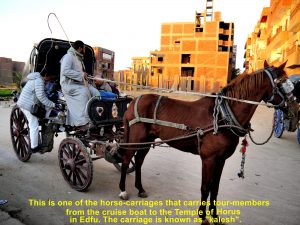
Tour group riding horse-drawn carriages from their cruise boat to the Edfu Temple or Temple of Horus
Ticket to enter Edfu Temple or Temple of Horus
Edfu Temple or Temple of Horus
Edfu Temple was built in the Ptolemaic Period(305-30 B.C.) for a falcon god known as Horus. Hence, it is also known as Temple of Horus.
Below are some photos of the Edfu Temple or Temple of Horus:
Facade or Pylon of the Edfu Temple
Tour group at the Edfu Temple
Statue of Horus on the left entrance of the Edfu Temple
Statue of Horus on the entrance of the Edfu Temple
Tour group in the Peristyle Hall of the Edfu Temple or Temple of Horus
Peristyle Hall in the foreground and Pylon of the Edfu Temple in the background
Passage from Hall of Offerings to the Horus Sanctuary in the Edfu Temple
Horus Sanctuary in the Edfu Temple. It houses a sacred boat of Horus in the rear of the Edfu Temple.
Blackened ceiling caused by arson in the Hypostyle Hall in the middle of the Edfu Temple
Egyptian tour-guide, Khaled, explaining the relief on a wall of the Edfu Temple
A relief on the back of the pylon of the Edfu Temple
Another relief on a wall of the Edfu Temple
Hieroglyphs on a wall of the Edfu Temple
Writer’ wife waiting in a “kalesha”(horse-drawn carriage) for other tour-members to return from the Temple of Horus
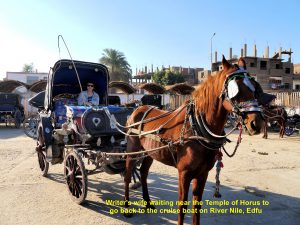
Writer’s wife on a “kalesha” waiting near the Temple of Horus for other members to go back to the cruise boat on River Nile at Edfu
Departure for Kom Ombo
After visiting the Edfu Temple for a couple of hours, we rode on “kaleshas” back to our cruise boat. Before noon our boat set sail again. It was sailing on River Nile further south to another historical place known as Kom Ombo.
Kom Ombo
On arrival at Kom Ombo in the afternoon, we disembarked the boat and walked a short distance to a temple which was on a low hill. It was known as Kom Ombo Temple.
Cruise Boat stopping at Kom Ombo
A ticket to enter Kom Ombo Temple and Crocodile Museum
Temple for Sobek and Horus
Known as Kom Ombo Temple, it was built in the Ptolemaic Dynasty(180-47 B.C.) for the Crocodile God, Sobek, and two more gods, and the Falcon God, Horus, and two more other gods.
Kom Ombo Temple built on a low hill near River Nile
Kom Ombo Temple was built for two sets of Gods
Side view of Kom Ombo Temple
Passage through Kom Ombo Temple
A relief showing medical information in Kom Ombo Temple
A relief showing a priest communicating with Sobek, the crocodile god. in the Kom Ombo Temple
A large stone block of Horus and Sobek outside the Kom Ombo Temple
A large stone block with hieroglyphs outside the Kom Ombo Temple
Top columns lying outside the Kom Ombo Temple
Nilometer outside the Kom Ombo Temple
It was used for measuring the level and checking the clarity of the water from River Nile
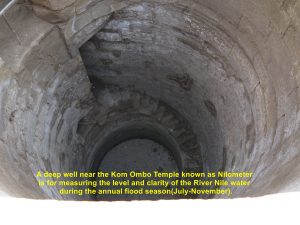
Nilometer near Kom Ombo Temple was used for measuring the level and checking the clarity of the water from River Nile
Crocodile Museum
At the foot of the hill there was a crocodile museum that housed some preserved crocodiles and live ones too.
Returning to the Cruise Boat
After visiting the Kom Ombo Temple and the crocodile museum, we walked back to our cruise boat.
“Galabia” Party Time on Cruise Boat
After dinner, it was fun and game time at a party for the tour group on the cruise boat. Some tour members dressed in Egyptian long clothes known as “galabia”. Koh, his wife and daughter were the most well-dressed in “galabia”.(see photo below)
The most well-dressed family in “galabia” was Koh family
Dances and Games
Our Egyptian tour-guide, Khaled, encouraged us to dance. Then he conducted a few fun games.
A Hilarious Game
One of the games had us in stitches. In that hilarious game, four male members had a small ball each that was hung on a string tied around his waist. They had to hit another ball to the finishing line on the floor. The player who got the ball to the finishing line first would be the winner. The winner for that game was Koh.
Some photos below showing the enjoyable activities at the “galabia” party”
Hitting a ball with another ball to the finishing line
Dancing
“Spoon Game”
After the party, we all retirned to our rooms on the cruise boat. The boat was sailing south to Aswan from Kom Ombo at night. The distance between them is 48 km.
Arrival at Aswan and Departure to Abu Simbel
In the early morning, our boat reached Aswan. After breakfast, we left the boat and travelled by coach through Sahara Desert to a place in the south known as Abu Simbel, another historical place.
(Continue in Egypt Travel Part VI)
Egypt Travel Parts I to XII
Egypt Travel Part I :Salah el Din Citadel, Muhammad Ali Mosque, Tahrir Square and Egyptian Museum
Egypt Travel Part II :Valley of the Kings, Hatshepsut Temple and Colossi of Memnon
Egypt Travel Part III :Hot Air Balloons and Karnak Temple Complex
Egypt Travel Part IV :Papyrus Paper-Making, Luxor Temple and Esna Lock
Egypt Travel Part V :Edfu Temple, Kom Ombo Temple and Galabia Party
Egypt Travel Part VI :Abu Simbel Temples and Nubian Village(Elephantine Island)
Egypt Travel Part VII :Unfinished Obelisk, Aswan High Dam and Philae Temple
Egypt Travel Part VIII:Ahmed Hamdi Tunnel, Moon Beach(Ras Sudr), and St. Catherine
Egypt Travel Part IX :Mount Sinai, Catherine’s Monastery and Sharm el Sheikh
Egypt Travel Part X :Sharm el Sheikh
Egypt Travel Part XI :Cairo Food, Saqqara Step Pyramid Complex and Memphis
Egypt Travel Part XII :Great Giza Pyramid Complex and Khan el Khalil Bazaar
Egypt Travel Part VI: Abu Simbel Temples and Nubian Village(Elephantine Island)
Egypt Travel Part VI: Abu Simbel Temples and Nubian Village(Elephantine Island)
Day 5 Sunday, 17 Dec 2017
Aswan to Abu Simbel by Coach
Early in the morning, we left our cruise boat on River Nile in Aswan and travelled south to Abu Simbel by coach to visit a temple complex, Abu Simbel Temple Complex, that consisted of two temples, the Great Temple and Small Temple.
Ticket to visit the Abu Simbel Temple Complex
Tour group posing a photo in front of the Great Temple on 17 Dec 2017
In front of the temple there are four large statues of King Ramesses II at different ages.
The Great Temple was built for three deitises, Ra-Harakhty, Ptah and Amun, and King Ramesses II(1303-1213 B.C.)
The Abu Simbel Temple Complex consists of the Great Temple and Small Temple.
They were built in the 1264-1244 B.C. period during the reign of King Ramesses II.
The Great Temple of the Abu Simbel Temple Complex was built for three deities and King Ramesses II
The Small Temple of the Abu Simbel Temple Complex was built for Goddess Hathor and King Ramesses II’s consort, Nefertari.
Writer holding an “ankh”(a cross with a handle) that symbolises life at the entrance of the Great Temple
Relocation of the Abu Simbel Temple Complex
Lake Nasser which is 200 metres from the Abu Simbel Temple Complex is a large artificial lake created by the construction of Aswan High Dam. It causes the relocation of the Abu Simbel Temple Complex to the present high ground in the period of 1964-1968 during which the dam was being built.
Lake Nasser. a large artificial lake, created by the construction of the Aswan High Dam
Returning to Aswan
Having seen the two temples of the Abu Simbel Temple Complex, we travelled back to our cruise boat at Aswan where we had lunch.
Felucca Sailing Boat Ride on River Nile
In the afternoon we boarded a wooden sailing boat known as felucca. It has a triangular sail known as lateen.
Feluccas sailing on River Nile, Aswan
Tour group boarding a felucca to experience the small wooden boat ride
Singing
As our felucca was sailing along River Nile, two crew men sang a few simple English songs and we joined them, too. After an hour on the felucca, we boarded a motor-boat that brought us to a Nubian village on Elephantine Island on River Nile and near Aswan City.
Two felucca crewmen were entertaining the tour group with simple English songs. The latter then joined them.
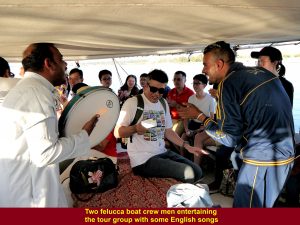
Two felucca crewmen were entertaining the tour group with simple English songs. The latter then joined them.
Mausoleum of Aga Khan III
On the way to a Nubian Village, we saw a pink building on a high bank of River Nile. It was Mausoleum of Aga Khan III built in 1959.
Sir Aga Khan III or Sultan Muhammed Shah(1877-1957) was the 48h. Iman of the Nizari Ismaili Community in Egypt. He died in 1957 and two years later he was buried in the mausoleum there requested by one of his wives.
Mausoleum of Aga Khan III sitting on a high bank of River Nile, Aswan
Nubian Village
Soon we reached the Nubian village. It was a small village with a few streets lined with stalls and shops. Most of them were selling souvenirs ranging from apparels to home-made jewellery.
A Nubian village on Elephantine Island
Tour group arriving at a Nubian village on Elephantine Island, Aswan
Figurines of Nubian people for sale at a stall in the village
Home-made jewellery for sale
A grocery shop selling coloured spices in the village
A grocery selling a wide variety of daily necessities in the village
A Small School
In the village, we entered a class-room in a small school and a Nubian teacher taught us some Arabic words.
A small Nubian village school on Elephantine Island, Aswan
Tour group learning some Arabic words at a Nubian small village school, on Elephantine Island, Aswan
Crocodiles
Then we visited a senior villager’s house where he treated us to some home-made bread and showed us his prized possessions which were crocodiles. He encouraged us to choose one for a camera-shot. A larger one could be seen in a locked cage.
Tour group tasting Nubian home-made bread at a senior villager’s house
The senior villager encouraged the group tour to choose a crocodile on a table for a camera-shot.
A brave tour-member holding a baby crocodile for a camera-shot while the senior villager was watching her
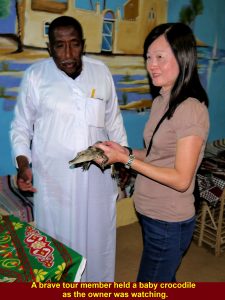
A brave tour member holding a baby crocodile for a camera shot while the senior villager was watching her
A young, brave tour-member holding a baby crocodile for a camera-shot
Tour group watching a large crocodile in a locked cage
Night scenes of Nubian village in the foreground and Aswan City in the background
A brightly-lit business street in the Nubian village
Another brightly-lit business street in the Nubian village
Tour Group leaving the Nubian Village
In the evening we left the Nubian Village and went back by a motor boat to our cruise boat to rest.
Tour group leaving the Nubian village by a motor-boat
(Continue in Egypt Travel Part VII)
Egypt Travel Parts I to XII
Egypt Travel Part I :Salah el Din Citadel, Muhammad Ali Mosque, Tahrir Square and Egyptian Museum
Egypt Travel Part II :Valley of the Kings, Hatshepsut Temple and Colossi of Memnon
Egypt Travel Part III :Hot Air Balloons and Karnak Temple Complex
Egypt Travel Part IV :Papyrus Paper-Making, Luxor Temple and Esna Lock
Egypt Travel Part V :Edfu Temple, Kom Ombo Temple and Galabia Party
Egypt Travel Part VI :Abu Simbel Temples and Nubian Village(Elephantine Island)
Egypt Travel Part VII :Unfinished Obelisk, Aswan High Dam and Philae Temple
Egypt Travel Part VIII:Ahmed Hamdi Tunnel, Moon Beach(Ras Sudr), and St. Catherine
Egypt Travel Part IX :Mount Sinai, Catherine’s Monastery and Sharm el Sheikh
Egypt Travel Part X :Sharm el Sheikh
Egypt Travel Part XI :Cairo Food, Saqqara Step Pyramid Complex and Memphis
Egypt Travel Part XII :Great Giza Pyramid Complex and Khan el Khalil Bazaar
Egypt Travel Part VII: Unfinished Obelisk, Aswan High Dam and Philae Temple
Egypt Travel Part VII: Unfinished Obelisk, Aswan High Dam and Philae Temple
Day 6 Monday, 18 Dec 2017
Unfinished Obelisk in Aswan
In the morning we left our cruise boat at Aswan and travelled to a place near the city to see an unfinished obelisk which was left attached to the bedrock in the quarries of granite over 3000 years ago. It was abandoned due to the formation of cracks in it. It was believed that the obelisk was ordered by Queen Hatshepsut(1508-1459 B.C.).
Ticket to see an unfinished obelisk in Aswan
Office and entrance to see the unfinished obelisk in Aswan
A short video clip about the unfinished obelisk was presented in the Office
The unfinished obelisk is located on a low hill of granite near the office, Aswan
Tour group walking up a low hill to see the unfinished obelisk
Tour group looking at the unfinished obelisk which was already cracked
The unfinished obelisk that was abandoned over 3000 years ago due to the formation of cracks in it
The unfinished obelisk was abandoned by Queen Hatshepsut(1508-1458) because it had formed cracks
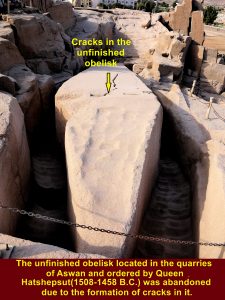
The unfinished obelisk ordered by Queen Hatshepsut(1508-1458 B.C.) was abandoned over 3000 years ago due to the formation of cracks in it.
Writer, wife, brother and sister-in-law at the site of the unfinished obelisk
Tour members, Peter Lim, and family were at the site, too.
Visiting Aswan High Dam
After seeing the unfinished but cracked obelisk, we travelled on the road to a large dam known as Aswan High Dam. We entered the dam area with a ticket. It was heavily guarded by soldiers.
Ticket to visit Aswan High Dam, Egypt
Purposes of Aswan High Dam
The dam was built across River Nile in Aswan in 1960-1970 period. It controls flooding, provides water for irrigation and generates hydro-electricity for industries.
Dam Dimensions
The dam is 111 metres high, 3830 metres long and 980 metres wide at its base.
2100 MW of Electricity
The large lake created by the dam is known as Lake Nasser on one side(south) and the water of the lake flows through the dam power stations into River Nile on the other side(north) generating 2100 MW of electricity.
Visitors at the Aswan High Dam
Lake Nasser, a large artificial lake, was created by the construction of the Aswan High Dam. It covers a surface area of 5250 sq. km.
Water from Lake Nasser flows through the dam and power stations into River Nile in the north
Diagram showing water flowing from Lake Nasser through the dam to the power stations and then to River Nile
Diagram showing the power stations that can generate hydro-electricity of 2100 MW capacity
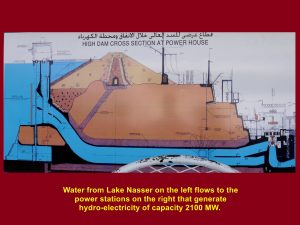
Diagram showing water flowing from Lake Nasser to the power stations generating hydro-electricity of capacity of 2100 MW
Writer and wife at the Aswan High Dam, Egypt
Visiting Philae Temple or Temple of Isis on Agilkia Island
Then we left the Aswan High Dam and moved on to another place to see an ancient temple. We had to take a motor-boat to a tiny island, Agilkia Island, in the Lake of Nasser. That temple is called Philae Temple or Temple of Isis. It was relocated to that island before its original site nearby was submerged by Lake Nasser in the 1970s.
Ptolemy II(Reign:285-246 B.C.)
The temple was constructed by Ptolemy II when he ruled Ptolemaic Egypt from 285 until 246 B.C. It was dedicated to Goddess Isis who was the wife of Osiris and mother of Horus. More parts were added to the main temple later by other Ptolemaic kings. Traces of the work done by some Roman emperors were discovered at the temple.
The Philae Temple or Temple of Isis was abandoned in the 6th. Century due to the arrival of Christianity and Islam.
Tour Group taking a motorboat from the Marina Philae Temple Jetty to Agilkia Island
Philae Temple or Temple of Isis is now on Agilkia Island in Aswan
Pylon or Facade of Philae Temple or Temple of Isis
Left Colonnades of Philae Temple or Temple of Isis
Right Colonnades of Philae Temple or Temple of Isis
Entrance of Sanctuary of Goddess Isis
Sanctuary of Goddess Isis
Egyptian Tour Guide talking about the Philae Temple or Temple of Isis to the Tour Group
A relief on a temple wall showing the figures of Goddess Isis
A defaced relief showing Goddess Isis watching a priest treating a sick person
A relief showing a priest offering food to Goddess Isis
A relief showing a priest worshipping Goddess Isis
Trajan’s Kiosk near the Temple of Isis was built by a Roman emperor, Trajan, who ruled his empire from 98 until 117 A.D..
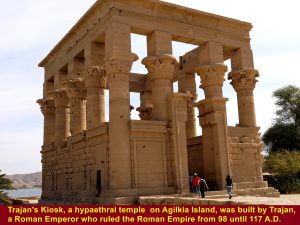
Trajan’s Kiosk was built near the Temple of Isis by a Roman emperor, Trajan who ruled his empire from 98 until 117 A.D.
An altar for making offerings to Goddess Isis
Writer and wife at the Philae Temple or Temple of Isis on 18 Dec 2017
Tour Group leaving Agilkia Island where the Philae Temple or Temple of Isis is located
Tour group going for a Nubian lunch at el Dokka Restaurant, Aswan
We returned to the Marina Temple Philae from Agilkia Island and took another boat to a tiny island to have a Nubian lunch at a restaurant known as el Dokka Restaurant in Aswan.
Tour group taking another boat from Marina Temple Philae to a small island for a Nubian lunch at el Dokka Restaurant in Aswan
Tour Group arriving at a tiny island for a Nubian lunch at el Dokka Restaurant
el Dokka Restaurant atop a rock
Dining Hall of el Dokka Restaurant, Aswan
A plate of Nubian fried chicken and rice
Nubian fried mushrooms and salad
A Nubian claypot dish
Nubian coffee for guests at el Dokka Restaurant, Aswan
A five-star hotel, Sofitel Legend Old Cataract Hotel, on the Bank of River Nile
Flying back to Cairo from Aswan
In the evening we took an airplane at Aswan International Airport and flew back to Cairo, a distance of 682 km, for an hour and 10 minutes.
On arrival at Cairo we checked in at Le Meridien Hotel. Early in the following morning, we left the hotel by coach for Sinai Peninsula in the east.
(Continue in Egypt Travel Part VIII)
Egypt Travel Parts I to XII
Egypt Travel Part I :Salah el Din Citadel, Muhammad Ali Mosque, Tahrir Square and Egyptian Museum
Egypt Travel Part II :Valley of the Kings, Hatshepsut Temple and Colossi of Memnon
Egypt Travel Part III :Hot Air Balloons and Karnak Temple Complex
Egypt Travel Part IV :Papyrus Paper-Making, Luxor Temple and Esna Lock
Egypt Travel Part V :Edfu Temple, Kom Ombo Temple and Galabia Party
Egypt Travel Part VI :Abu Simbel Temples and Nubian Village(Elephantine Island)
Egypt Travel Part VII :Unfinished Obelisk, Aswan High Dam and Philae Temple
Egypt Travel Part VIII:Ahmed Hamdi Tunnel, Moon Beach(Ras Sudr), and St. Catherine
Egypt Travel Part IX :Mount Sinai, Catherine’s Monastery and Sharm el Sheikh
Egypt Travel Part X :Sharm el Sheikh
Egypt Travel Part XI :Cairo Food, Saqqara Step Pyramid Complex and Memphis
Egypt Travel Part XII :Great Giza Pyramid Complex and Khan el Khalil Bazaar
Egypt Travel Part VIII: Ahmed Hamdi Tunnel, Moon Beach(Ras Sudr) and St. Catherine
Egypt Travel Part VIII: Ahmed Hamdi Tunnel, Moon Beach(Ras Sudr) and St. Catherine
Day 7 Tuesday, 19 Dec 2017
Early in the morning, we left Cairo and would be on a long journey on the road by coach to St. Catherine and then to Sharm el Sheikh in Sinai Peninsula, Egypt.
Coach bringing tour group from Cairo to Sinai Peninsula
Map showing the places with names in blue in Sinai Peninsula the tour group were going to stop or visit
Ahmed Hamdi Tunnel
To go to Sinai Peninsula from Cairo our coach had to go through a tunnel under the Suez Canal. Known as Ahmed Hamdi Tunnel it is about 1.63 km long and about 120 km east of Cairo. It was opened in 1981 and reopened in 1992.
A place near the entrance of Ahmed Hamdi Tunnel from Suez to Sinai Peninsula
Part of the Ahmed Hamdi Tunnel as seen from the writer’s moving coach.
Sinai Peninsula is a desert area with very little vegetation and rain. The roads were straight and looked new.
Moses’ well in Elim
On the way to St. Catherine we stopped at a place, Elim, which is 100 km south-east of the tunnel in Suez. There was a well in its oasis. It was one of the 12 wells used by Prophet Moses and his followers, Israelites, who were on their way to the promised land.
Moses crossed the Red Sea
According to the Book of Exodus, Moses led Israelites to escape from the ancient Egyptian army. They then crossed the Red Sea parted by God to a promised land in Sinai Peninsula.
On the way to the promised land, they stopped at several wells. One of them was at in the Elim oasis.
A painting showing Moses leading Israelites across the Red Sea parted by God to a promised land in Sinai Peninsula. They were being pursued by their enemies, the ancient Egyptian army.
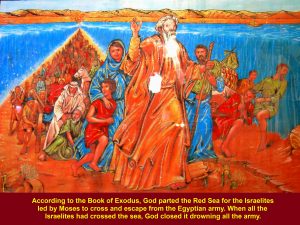
Moses leading Israelites and crossing the Red Sea parted by God to escape from the ancient Egyptian army, according to the Book of Exodus.
Tour group stopped at Elim which is 100 km south-east of Suez to see one of the 12 Moses’ wells in the oasis.
The Israelites led by Moses stopped and camped at the well for a short while before they continued their journey to the promised land, according to the Book of Exodus.
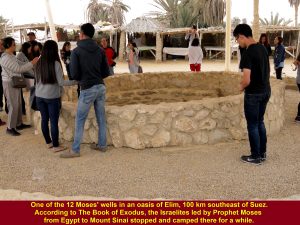
One of 12 Moses’ wells in Elim where the Israelites led by Moses stopped and camped there for a while
Unoccupied Houses
On the journey in northern Sinai Peninsula, we noticed many houses were unoccupied by civilians. It was due to Sinai insurgency between the Islamist militants and the Egyptian security forces. Besides, the civilians were afraid of being attacked by the militants.
Unoccupied houses by civilians along highways in northern Sinai Peninsula
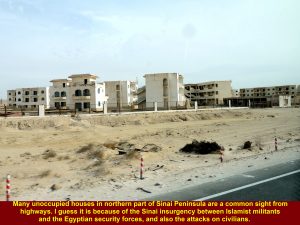
Unoccupied houses by civilians along highways in northern Sinai Peninsula due to Sinai insurgency, and civilian attacks by the militants
Lunch at Moon Beach Resort Restaurant, Ras Sudr
Tour group stopped at Moon Beach Resort Restaurant, Ras Sudr, for lunch after travelling 226 km by road from Cairo.
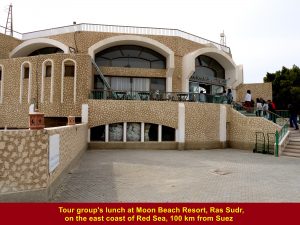
Tour group stopping at Moon Beach Resort Restaurant, Ras Sudr. for lunch after travelling 226 km by road from Cairo
Lunch in dining hall of Moon Beach Restaurant, Ras Sudr
Calm Red Sea and quiet beach of Moon Beach Resort, Ras Sudr, Sinai Peninsula, Egypt
Leaving Ras Sudr after lunch
After lunch we left Ras Sudr and travelled another 200 km to St. Catherine. But two hours later, we stopped at a roadside cafe for tea-break.
Tea-break at a roadside cafe.
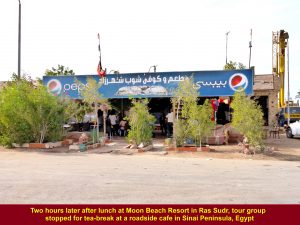
Tour group stopping at a roadside cafe for tea-break after having lunch at Ras Sudr about two hours ago
Tour group relaxing at a roadside cafe for a short while before they continued their journey to St. Catherine in the south.
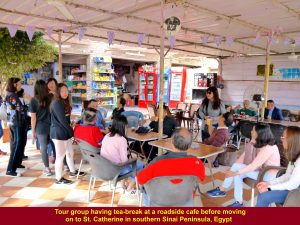
Tour group having a drink and relaxing at the roadside cafe before going to St. Catherine in the south
Egypt-Israel Peace Treaty(1979)
Sinai Peninsula was occupied by the Israeli forces from 1967 until 1982. It was returned to Egypt in 1982 although the Peace Treaty between them was signed in 1979.
Sinai Peninsula was occupied by Israeli forces from 1967 until 1982.
Arrival at St. Catherine
After a long journey from Cairo via the Suez tunnel, we finally reached St. Catherine in Sinai Peninsula. We had travelled a total distance of abou 440 km on the road from Cairo to St. Catherine during the whole day.
We would stay at a hotel, Morgenland Hotel, for a night. But some of us would leave the place after midnight and travelled 6.7 km to the foot of a mountain, Mount Sinai, which is 2285 metres above sea-level and then climbed up the mountain to its peak in pitch-darkness.
A large billboard welcoming visitors to St. Catherine in South Sinai Peninsula, Egypt
Tour group resting at Morgenland Hotel at St. Catherine before climbing Mount Sinai(2285 metres) after midnight.
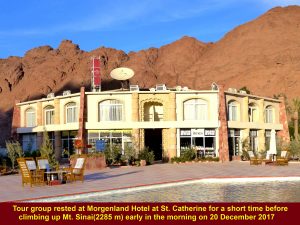
Tour group resting at Morgenland Hotel at St. Catherine before climbing Mount Sinai(2285 metres) which is 6.7 km away after midnight
Writer and wife at Morgenland Hotel, St. Catherine, on 19 Dec 2017
Moses received the Ten Commandments on Mt. Sinai
According to the Book of Exodus, Moses went up Mt. Sinai to receive two tablets of stone inscribed with the God’s Ten Commandments.
Mount Sinai, a tourists’ popular site
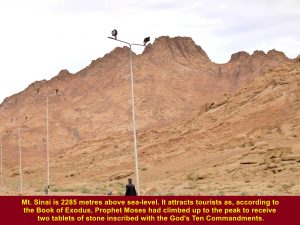
Mt. Sinai attracts tourists as, according to the Book of Exodus, Moses had gone up to receive two tablets of stone inscribed with the God’s Ten Commandments
Writer getting ready to climb Mt. Sinai with other tour members after midnight on 20 Dec 2017
(Continue in Egypt Travel Part IX)
Egypt Travel Parts I to XII
Egypt Travel Part I :Salah el Din Citadel, Muhammad Ali Mosque, Tahrir Square and Egyptian Museum
Egypt Travel Part II :Valley of the Kings, Hatshepsut Temple and Colossi of Memnon
Egypt Travel Part III :Hot Air Balloons and Karnak Temple Complex
Egypt Travel Part IV :Papyrus Paper-Making, Luxor Temple and Esna Lock
Egypt Travel Part V :Edfu Temple, Kom Ombo Temple and Galabia Party
Egypt Travel Part VI :Abu Simbel Temples and Nubian Village(Elephantine Island)
Egypt Travel Part VII :Unfinished Obelisk, Aswan High Dam and Philae Temple
Egypt Travel Part VIII:Ahmed Hamdi Tunnel, Moon Beach(Ras Sudr), and St. Catherine
Egypt Travel Part IX :Mount Sinai, Catherine’s Monastery and Sharm el Sheikh
Egypt Travel Part X :Sharm el Sheikh
Egypt Travel Part XI :Cairo Food, Saqqara Step Pyramid Complex and Memphis
Egypt Travel Part XII :Great Giza Pyramid Complex and Khan el Khalil Bazaar
Egypt Travel Part IX: Mount Sinai, St. Catherine’s Monastery and Sharm el Sheikh
Egypt Travel Part IX: Mount Sinai, St. Catherine’s Monastery and Sharm el Sheikh
Day 8 Wednesday, 20 December 2017
Map showing the location of Mount Sinai near St. Catherine’s Monastery in south Sinai Peninsula, Egypt
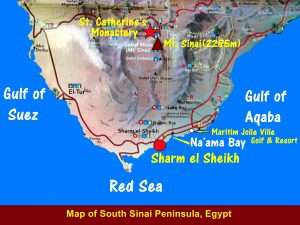
Map showing the location of Mount Sinai near St. Catherine’s Monastery in south Sinai Peninsula, Egypt
Mt. Sinai Climb
It was at 1 a.m. on 20 Dec 2017 that we started the climb to the top of Mt. Sinai in St. Catherine, Sinai Peninsula, Egypt. The mountain was 2282 metres above sea-level.
Tour members starting the Mt. Sinai climb in St. Catherine at 1 a.m. on 20 Dec 2017
Moonless Night
The lower mountain path was lit for a hundred metres then headlamps or torchlights had to be used to see the stony path to the summit in pitch darkness on the moonless night. The climb was easy at the beginning but later it was tough as the mountain guide allowed us a two-minute rest at each stop.
Resting at a Shelter
After two hours of climbing(3 a.m.), three of us including my brother gave up and rested at a shelter while the rest continued the climb to the summit of Mt. Sinai.
Colourful Sunlight
At about 5.0o a.m. I stood outside the shelter and was fascinated to see the colourful sunlight appearing on the eastern horizon.
Colourful sunlight at 5 a.m.
Bright Yellow Sun
Later at 5.40 a.m., I saw the bright yellow sun peeping out of the horizon. Soon the whole surrounding was brightened up.
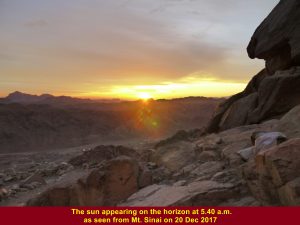
The sun appearing on the horizon at 5.40 a.m. on 20 Dec 2017 as seen from the rest shelter on Mt. Sinai
Bright Morning
When the morning was bright, I could see the stone-shelter where we rested earlier and the summit of Mt. Sinai in the distance, clearly. But those who went up to the summit had not come down yet.
Stone-shelter and Mt. Sinai in the morning
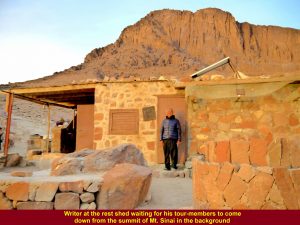
Writer at the rest shelter waiting for his tour members to return from the summit of Mt. Sinai(2285 metres above sea-level)
Friendly cafe owner
The owner of the shelter-cafe was a friendly Egyptian. He had been serving climbers for several years.
Arrival of Tour-Members
At about 6.20 a.m. the rest of the climbers arrived at the shelter but did not stop there. So three of us who had remained at the shelter overnight followed them down the mountain. They told us that when they reached the summit it was still dark, but the mountain guide told them that they could not wait there to see the sunrise. He was told by our Egyptian tour-guide, Khaled, to descend immediately as we had to visit St. Catherine’s Monastery which would close at 12 noon.
Disappointment
The successful climbers felt disappointed and had to go down the mountain. But, fortunately, they did see the sunrise later as they were descending.
Tour members arriving at the shelter at 6.20 a.m. on 20 Dec 2017
Peter Lim and his happy family posing for a photo at the shelter.
Tour members descending Mt. Sinai in the morning on 20 Dec 2017
Tour members taking a long journey down Mt. Sinai
Book of Exodus
According to the Book of Exodus, Moses went up to the summit to receive the Ten Commandments from God.On
Chapel and Mosque on Summit
On the summit of Mt. Sinai the climbers saw an Orthodox Chapel of the Holy Trinity which was built in 1934 on ruins of a 4th. Century Byzantine church and a 12th. Century mosque nearby.
Summit of Mt. Sinai
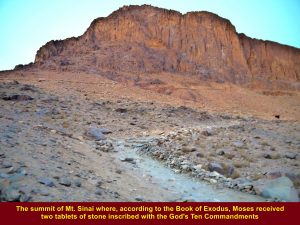
According to the Book of Exodus, Moses went up to the Mt. Sinai summit to receive the Ten Commandments from God
A painting showing Moses receiving two tablets of stone inscribed with the God’s Ten Commandments.
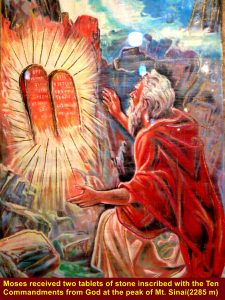
Moses on the Mi. Sinai summit receiving two tablets of stone inscribed with the God’s Ten Commandments, according to the Book of Exodus
Painting showing Moses with the Ten Commandments descending Mt. Sinai
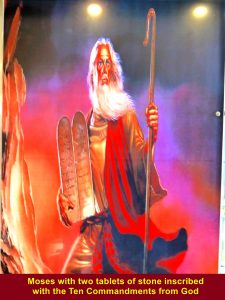
Moses with two tablets of stone inscribed with the Ten Commandments descending Mount Sinai to see his people
Visiting St. Catherine’s Monastery
After the mountain climb, we returned to our hotel, Morgenland Hotel, took a quick bath and breakfast, and packed our luggage getting ready to go to St. Catherine’s Monastery which was 10 km away. Then our coach brought us to a place where we took a van-taxi that took us to the monastery, a km away.
Tour group stopping at a place to take a van-taxi to St. Catherine’s Monastery, a km away
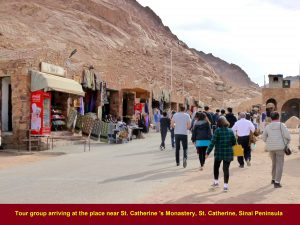
After the Mt. Sinai climb, we were brought by our coach to a place near the St. Catherine’s Monastery that is 10 km from Morgenland Hotel
A km-ride to the monastery by van-taxi
About St. Catherine’s Monastery
St. Catherine’s Monastery located at the foot of Mt. Sinai was built by the order of a Byzantine emperor, Justinian I, in the 6th. Century A.D.. It has become a sacred place for pilgrimage.
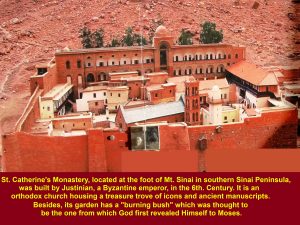
St. Catherine’s Monastery was built by order of Justinian I, a Byzantine emperor in the 6th. Century A.D.
The Monastery’s Treasure
St. Catherine’s Monastery houses a treasure trove of icons and manuscripts. It is surrounded by high thick walls with small entrance and windows to prevent it from being attacked by unknown people.
6th. Century Monastery
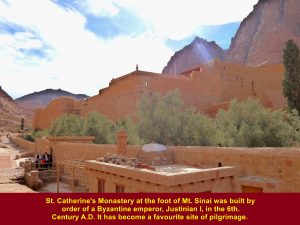
St. Catherine’s Monastery was built order of a Byzantine emperor, Justinian I, in the 6th. Century A.D.
Main Entrance of Monastery
Monastery’s Compound
High and Thick Wall surrounding the Monastery
Orthodox Church where no photographing was allowed inside
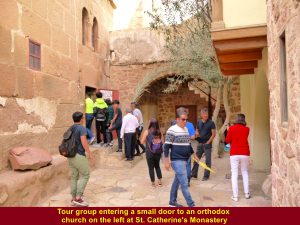
Tour group entering an orthodox church on the left. Visitors were not allowed to take photos inside.
Moses’ Well where Moses met his wife, Zipporah
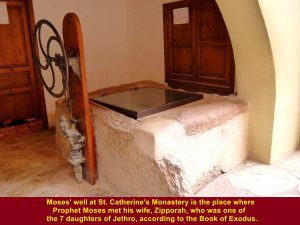
Moses’ Well, the place where Moses met his wife, Zipporah, who was one of the 7 daughters of Jethro, according to the Book of Exodus
“Burning Bush”
“Burning Bush” in the Monastery garden from which God first revealed himself to Prophet Moses, according to the Book of Exodus
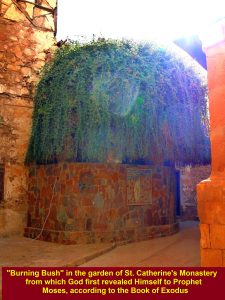
“Burning Bush: in the garden of the monastery from which God first revealed Himself to Prophet Moses, according to the Book of Exodus
Group tour photo at St. Catherine’s Monastery on 20 Dec 2017
St. Catherine’s Legend
According to legend, Catherine was a Christian martyr from Alexandria. She was sentenced to death on the breaking wheel that was supposed to kill her. Since it failed, she was beheaded. Later angels took her body to Mount Sinai. In around 800 A.D. monks from the monastery found her body and kept her in the Orthodox church. Thus. the monastery was named after her.
Mosque at St. Catherine’s Monastery
There is a mosque behind the Bell Tower at St. Catherine’s Monastery. Originally, it was built as a hospice for Christian pilgrims. Then in 1106 it was converted to that mosque for the use of local Bedouins , some of them were working for the monastery. It is still in use today.
A mosque at St. Catherine Monastery
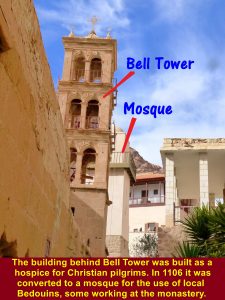
Building behind Bell Tower was converted to a mosque for the use of the local Bedouins in 1106, some working for the monastery.
Travelling south to Sharm el Sheikh
In the late afternoon on 20 Dec 2017, we left St. Catherine’s Monastery and headed south to a famous coastal tourist town in Egypt, Sharm el Sheikh. On arrival we checked in at a well-known hotel, Maritim Jolie Ville Golf and Resort.
Map showing the southern part of Sinai Peninsula
Maritim Jolie Ville Golf & Resort, Sharm el Sheikh
A lovely resort that has many facilities, like swimming pools, tennis courts, 18-hole golf course, over 300 rooms, beach for swimming in the Red Sea, restaurant, bar, etc..
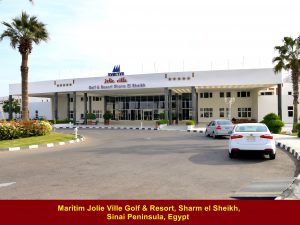
Tour group stayed for two nights at Maritim Jolie Ville Golf & Resort in Sharm el Sheikh on 20-21 Dec 2017
Fresh water and sea-water swimming pools at the resort
Beach for swimming in the clear water of the Red Sea
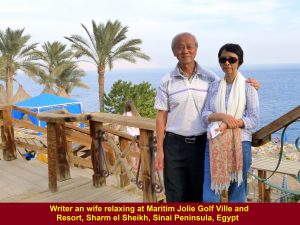
Writer and wife relaxing at Maritim Jolie Golf Ville and Resort, Sharm el Sheikh, Sinai Peninsula, Egypt
Resting at Resort
We stayed at that resort for that night and would go to Naama Bay for a submarine ride to see marine life in the bay on the following day, 21 Dec 2017.
(Continue in Egypt Travel Part X)
Egypt Travel Parts I to XII
Egypt Travel Part I :Salah el Din Citadel, Muhammad Ali Mosque, Tahrir Square and Egyptian Museum
Egypt Travel Part II :Valley of the Kings, Hatshepsut Temple and Colossi of Memnon
Egypt Travel Part III :Hot Air Balloons and Karnak Temple Complex
Egypt Travel Part IV :Papyrus Paper-Making, Luxor Temple and Esna Lock
Egypt Travel Part V :Edfu Temple, Kom Ombo Temple and Galabia Party
Egypt Travel Part VI :Abu Simbel Temples and Nubian Village(Elephantine Island)
Egypt Travel Part VII :Unfinished Obelisk, Aswan High Dam and Philae Temple
Egypt Travel Part VIII:Ahmed Hamdi Tunnel, Moon Beach(Ras Sudr), and St. Catherine
Egypt Travel Part IX :Mount Sinai, Catherine’s Monastery and Sharm el Sheikh
Egypt Travel Part X :Sharm el Sheikh
Egypt Travel Part XI :Cairo Food, Saqqara Step Pyramid Complex and Memphis
Egypt Travel Part XII :Great Giza Pyramid Complex and Khan el Khalil Bazaar
Egypt Travel Part X: Sharm el Sheikh, Naama Bay, Submarine Ride, Old Market, Sahaba Mosque
Egypt Travel Part X: Sharm el Sheikh, Naama Bay, Submarine Ride, Old Market, Sahaba Mosque
Day 9 Thursday, 21 December 2017
Naama Bay, Sharm el Sheikh, Sinai Peninsula
On the second day at Sharm el Sheikh, we left Maritim Jolie Golf Ville and Resort and went to Naama Bay which was a few km from the resort. We were going to be in a moving submarine to see marine life in the bay.
Map showing the location of Sharm el Sheikh
Bill-board advertising submarine service
When we arrived at the Naama Bay, we saw a large bill-board advertising the submarinc service.
Submarine service at Naama Bay, Sharm el Sheikh
Tour members were briefed about the marine life in Naama Bay by a submarine company worker before entering a submarine.
A submarine jetty at Naama Bay, Sharm el Sheikh
Clear, blue water in Naama Bay, Sharm el Sheikh
Submarines waiting for tourists to board at Naama Bay jetty
More tourist submarines
A submarine with tourists moving to the deep water of Naama Bay
Writer and wife relaxing on a submarine before it started to move
Parasailing is one of the tourists’ activities at Naama Bay
“Banana” ride is another tourist activity at Naama Bay
Tour members inside the moving submarine were fascinated by marine fish swimming about, plants and corals in the water.
Corals, marine plants and fish are plenty in Naama Bay, Sharm el Sheikh, Sinai Peninsula
Large and small fish of diverse kinds in Naama Bay
Old Market in Sharm el Sheikh
After the interesting and exciting submarine ride in Naama Bay, we went to the Old Market of Sharm el Sheikh which was about two km from Naama Bay.
Variety of Shops
It is a well-planned town with shops of many kinds that sell things ranging from daily necessities, foods, beverages to jewellery and electrical goods.
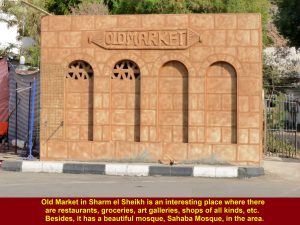
Old Market in Sharm el Sheikh has all kinds of shops like restaurants, groceries, art galleries, etc.
Writer’s wife at Old Market of Sharm el Sheikh on the sunny day.
A street of shops at Old Market, Sharm el Sheikh
Old Market Bazaar, Sharm el Sheikh
Sahaba Mosque
The largest and most prominent building at Old Market is a mosque, Sahaba Mosque, built in Ottoman architectural style in 2011.
Back to Resort for Dinner
In the evening we left Old Market and went back to our resort, Maritim Jolie Golf Ville and Resort, to have dinner. We stayed one more night there as we would fly back to Cairo from Sharm el Sheikh on the following morning on 22 Dec 2017.
(Continue in Egypt Travel Part XI)
Egypt Travel Parts I to XII
Egypt Travel Part I :Salah el Din Citadel, Muhammad Ali Mosque, Tahrir Square and Egyptian Museum
Egypt Travel Part II :Valley of the Kings, Hatshepsut Temple and Colossi of Memnon
Egypt Travel Part III :Hot Air Balloons and Karnak Temple Complex
Egypt Travel Part IV :Papyrus Paper-Making, Luxor Temple and Esna Lock
Egypt Travel Part V :Edfu Temple, Kom Ombo Temple and Galabia Party
Egypt Travel Part VI :Abu Simbel Temples and Nubian Village(Elephantine Island)
Egypt Travel Part VII :Unfinished Obelisk, Aswan High Dam and Philae Temple
Egypt Travel Part VIII:Ahmed Hamdi Tunnel, Moon Beach(Ras Sudr), and St. Catherine
Egypt Travel Part IX :Mount Sinai, Catherine’s Monastery and Sharm el Sheikh
Egypt Travel Part X :Sharm el Sheikh
Egypt Travel Part XI :Cairo Food, Saqqara Step Pyramid Complex and Memphis
Egypt Travel Part XII :Great Giza Pyramid Complex and Khan el Khalil Bazaar
Egypt Travel Part XI: Cairo Food, Saqqara and Memphis
Egypt Travel Part XI: Cairo Food, Saqqara and Memphis
Day 10 Friday, 22 December 2017
Flight back to Cairo
In the morning of 22 Dec 2017, we flew back to Cairo from Sharm el Sheikh in southern Sinai Peninsula.
Map showing the air-flight route from Sharm el Sheikh to Cairo
Departure from Sharm el Sheikh, Sinai Peninsula
Tour group leaving Sharm el Sheikh International Airport for Cairo in the north-west of Egypt on 22 Dec 2017.
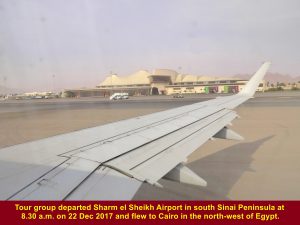
Tour group leaving Sharm el Sheikh Airport in south Sinai Peninsula for Cairo in the north-west in Egypt on 22 Dec 2017
Arrival at Cairo
More than an hour later, tour group arrived and landed at Cairo International Airport at 9.40 a.m. and noticed that it was shrouded in haze. The haze was caused by fine particles blown from the Sahara Desert in the west and smoke from vehicles in the city and open burning in its outskirt.
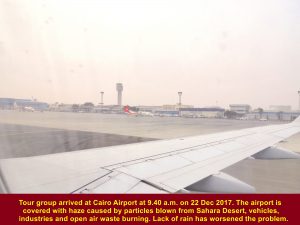
Tour group arrived at Cairo Airport from Sharm el Sheikh at 9.40 a.m. on 22 Dec 2017 and the airport was shrouded in haze.
Lunch at Alezba Village Restaurant, Cairo
Tour group boarded a coach at the Cairo airport and went to a place, Alezba Village Restaurant, in the city for a buffet lunch.

Tour group arriving at 9.40 a.m. at Cairo International Airport from Sharm el Sheikm, Sinai Peninsula
Tour group entering Alzeba Village Restaurant for lunch.
A garden at Alzeba Village Restaurant, Cairo
A worker making freshly baked bread in a traditional oven
Eating place at Alzeba Village Restaurant, Cairo
Tour group helping themselves to many kinds of dishes at the restaurant
Tour members queuing up for food
Tour members going for more food?
This is writer’s lunch at Alzeba Village Restaurant, Cairo.
Grilled chicken meat, anyone?
Lim family members, including writer, having lunch at the restaurant
Teo and wife, and Neoh and wife having lunch at the restaurant
Tay and family having lunch at the restaurant
Samuel Koh and family having lunch at the restaurant
Tan and family having lunch at the restaurant
Peter Lim and family having lunch at the restaurant
Liew and family having lunch at the restaurant
Evi Cuaca and mother having lunch at the restaurant
Gan and Chew having lunch at the restaurant
Visiting two historical places in the south of Cairo
After the delicious, sumptuous meal at Alezba Village Restaurant in Cairo, the tour group travelled several km south of Cairo to visit two historical places, Saqqara and Memphis.
Map showing the location of Saqqara and Memphis
Ticket to see the Step Pyramid Comples in Saqqara
Step Pyramid of King Djoser
Tour group entered the Step Pyramid Complex and saw the Pyramid of King Djoser built in 2700 B.C. by Imhotep, a famous ancient Egyptian architect. It was meant as a tomb for King Djoser who ruled ancient Egypt from 2667-2648 B.C..
The pyramid consists of six square mastabas, one on top of each other and the top one is smaller than the bottom one. The height of the pyramid is about 62 metres.
Writer and wife at the Step Pyramid Complex, Saqqara, Egypt
Court of Columns, an entrance to Step Pyramid Complex, Saqqara, Egypt
Funerary Temple near Step Pyramid of King Djoser, Saqqara, Egypt
A smaller ruined tomb at Step Pyramid Complex, Saqqara, Egypt
Remains of a ruined temple at Step Pyramid Complex, Saqqara, Egypt
Remains of a ruined house at Step Pyramid Complex, Saqqara, Egypt
Visiting Memphis, the oldest capital of Egypt
Having seen enough of Step Pyramid Complex in Saqqara, we went to another place nearby. It was the oldest capital of Egypt known as Memphis. It was established by the first pharaoh, Menes, on the west bank of River Nile. The king founded the First Dynasty more than 5000 years ago.
Decline of Memphis
When the Romans arrived in Egypt, Memphis lost its importance to Alexandria in the north which was nearer to the Roman Empire. Its ruins are located near a town, Mit Rahina, 20 km south of Cairo.
Ticket to enter Mit Rahina Museum, Mit Rahina, Egypt
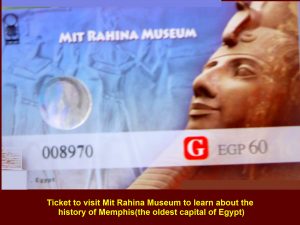
Ticket to visit Mit Rahina Museum to learn about the history of the oldest capital of Egypt, Memphis
Mit Rahina Museum
Mit Rahina houses a large statue of King Ramesses II(1303-1213) and many artifacts of the ancient temples of Memphis.
A huge statue of King Ramesses II in the museum
The statue of King Ramesses II was found face down in a marshy ground in Mit Rahina in 1821
Ancient Temples and tombs around Mit Rahina Museum
There are several ancient temples sited around Mit Rahina Museum such as Ptah Temple, Ramesses II Temple, Hathor Temple and Tombs of High Priests, too.
Open air museum outside Mit Rahina Museum
Relics of ancient temples and chapels in the open air museum of Mit Rahina Museum
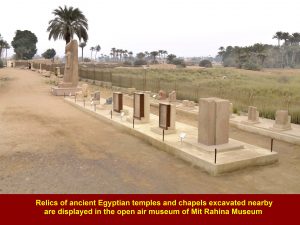
Relics of ancient temples and chapels excavated nearby are displayed in the open air museum of Mit Rahina Museum
Lim family members including writer posing in front of the second largest Sphinx in Egypt in the open air museum
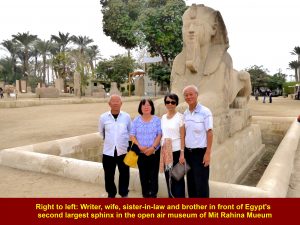
Right to left: Writer, wife. sister-in-law and brother standing in front of Egypt’s seond largest Sphinx in the open air museum of Mit Rahina Museum
Writer and wife standing in front of a tall statue of Ramesses II in the open air museum
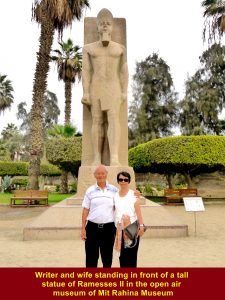
Writer and wife standing in front of a tall statue of Ramesses II in the open museum of Mit Rahina Museum
A friendly guard standing next to a headless statue of Ramesses II in the open air museum
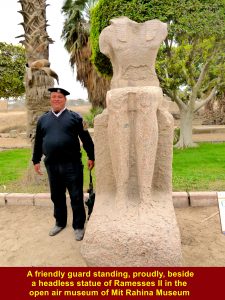
A friendly guard standing, proudly, next to a headless statue of Ramesses II in the open air museum of Mit Rahina Museum
“Triad of Memphis” in the open air museum was a family of three gods: Great God Ptah(middle), his wife, Sekhmet(on his left), and King Ramesses II as his son, Nefertum(on his right).
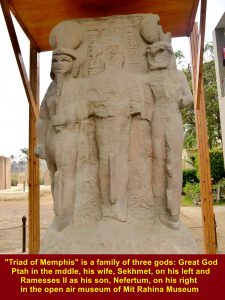
“Triad of Memphis” was a family of three gods: Great God Ptah(middle), his wife, Sekhmet(on his left), and Ramesses II as his son, Nefertum(on his right), in the open air museum
Bust of Goddess Hathor with cow ears
Bust of Goddess Hathor with cow ears in the open air museum was a symbol of love, motherhood and music, and provider of food, milk and produce.
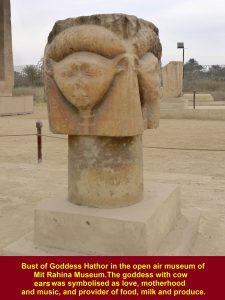
Bust of Goddess Hathor is in the open air museum. She with cow ears was symbolised as love, motherhood and music, and provider of food, milk and produce.
Mummification Bed
Mummification bed on which dead bodies were washed clean, and their organs removed before being wrapped in linen a few time. Then they were kept in sarcophaguses(coffins).
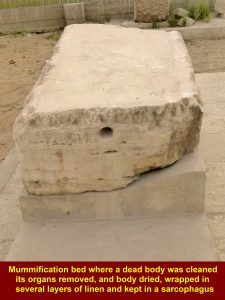
Mummification bed on which dead bodies were washed clean, and their organs removed before being wrapped in linen a few times. Then they were kept in sarcophaguses(coffins).
Diagram showing steps for ancient Egyptian mummification
Egyptian tour-guide, Khaled, telling the tour group about the history of Memphis outside the Mit Rahina Museum
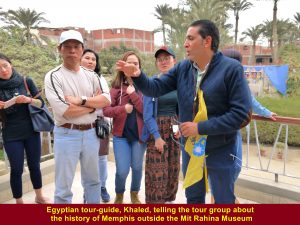
Egyptian tour-guide, Khaled, telling the tour group about the history of Memphis outside the Mit Rahina Museum
Back to Cairo from Mit Rahina Museum
After an interesting visit to Mit Rahina Museum learning about the ancient history of Memphis, we headed back to Le Meridien Hotel in Cairo for dinner.
(Continue in Egypt Travel Part XII Final)
Egypt Travel Parts I to XII
Egypt Travel Part I :Salah el Din Citadel, Muhammad Ali Mosque, Tahrir Square and Egyptian Museum
Egypt Travel Part II :Valley of the Kings, Hatshepsut Temple and Colossi of Memnon
Egypt Travel Part III :Hot Air Balloons and Karnak Temple Complex
Egypt Travel Part IV :Papyrus Paper-Making, Luxor Temple and Esna Lock
Egypt Travel Part V :Edfu Temple, Kom Ombo Temple and Galabia Party
Egypt Travel Part VI :Abu Simbel Temples and Nubian Village(Elephantine Island)
Egypt Travel Part VII :Unfinished Obelisk, Aswan High Dam and Philae Temple
Egypt Travel Part VIII:Ahmed Hamdi Tunnel, Moon Beach(Ras Sudr), and St. Catherine
Egypt Travel Part IX :Mount Sinai, Catherine’s Monastery and Sharm el Sheikh
Egypt Travel Part X :Sharm el Sheikh
Egypt Travel Part XI :Cairo Food, Saqqara Step Pyramid Complex and Memphis
Egypt Travel Part XII :Great Giza Pyramid Complex and Khan el Khalil Bazaar
Egypt Travel Part XII(Final): Great Giza Pyramid Complex and Khan el Khalil Bazaar
Egypt Travel Part XII(Final): Great Giza Pyramid Complex and Khan el Khalil Bazaar
Day 11 Saturday, 23 December 2017
This day was our last day of our visit in Egypt. We had two more places to go, namely, Great Giza Pyramid Complex in the Cairo outskirt and the largest bazaar, Khan el Khalil Bazaar, in Egypt that is in the Cairo city.
In the morning, we left our hotel, Le Meridien Hotel, in the outskirt of Cairo city and travelled a short distance to Giza.
Map showing the location of Giza where the Great Giza Pyramid Complex is.
Ticket to visit the Great Giza Pyramid Complex in Giza in Egypt
The Great Giza Pyramid Complex
This place was a cemetery or necropolis for ancient Egyptian kings, queens and noblemen who lived about 4500 years ago. It is the only place in the world where the deceased were buried in large or small pyramids. Besides, there are tombs, too.
Location of the important pyramids at the Great Giza Pyramid Complex, Egypt
The important pyramids at Great Pyramid Complex, Egypt
The oldest, largest and highest pyramid at this complex is the Pyramid of Khufu(died in 2566 B.C.), second, Pyramid of Khafre(died in 2480 B.C.), and third, Pyramid of Menkaure(died in 2500 B.C.). Besides, there are three small pyramids for queens, tombs for other queens and cemeteries for noblemen.
Pyramid of Khufu
Tour group posing in front of Pyramid of Khufu also known as the Great Pyramid of Giza. It is the largest, oldest and highest pyramid in Egypt and the world too. Its height is 146.7 metres.
Writer, wife, sister-in-law and brother(left to right) at the Great Pyramid of Giza or Pyramid of Khufu
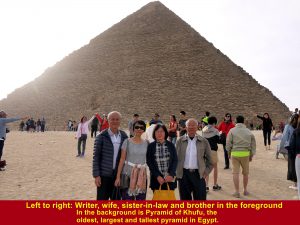
Writer, wife , brother and sister-in-law posing in front of Pyramid Khufu, the oldest, largest and tallest pyramid in Egypt and the world too.
Pyramid of Khufu has an entrance and air shaft leading to the tombs of the King and Queen inside.
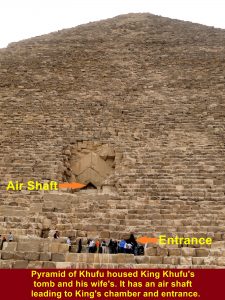
Pyramid of Khufu houses the tombs of King Khufu and his queen. It has air-shaft and entrance to their tombs inside.
Pyramid of Khafre
Pyramid of Khafre is the second largest and highest pyramid in Egypt. Its height is 136.4 metres. Khaftre was King Khufu’s son who died in 2480 B.C..
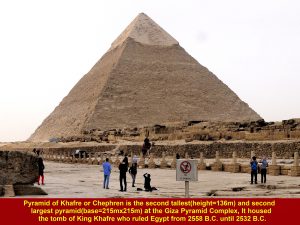
Pyramid of Khafre is the second largest and tallest pyramid in Egypt. Khafre was Khufu’s son who died in 2480 B.C..
Great Sphinx
There is a large statue of a mythical creature that has a lion’s body and human head several hundred metres from the Pyramid of Khafre. It is known as the Great Sphinx, the largest figure in the world. It was created during the reign of King Khafre from 2558 until 2532 B.C..
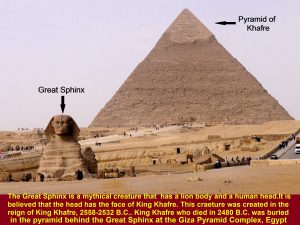
Great Sphinx is located further down the Pyramid of Khafre. It was created during the reign of King Khafre(2558-2532 B.C.)
Writer’s wife and tour members posing in front of the Great Sphinx and the Pyramid of Khafre behind the sphinx
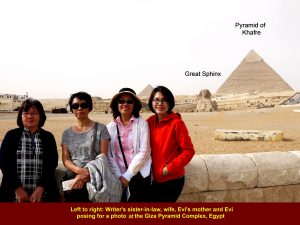
Writer’s wife and tour members posing for a photo in front of the Great Sphinx, Giza Pyramid Complex, Egypt
Writer and wife trying to “touch” the top of the Pyramid of Khafre
Funerary Temple
A funerary temple was built at every pyramid for worshipping the deceased king or queen. Food and objects were offered to the deceased.
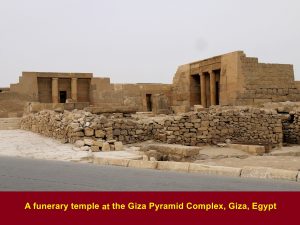
A funerary temple at every pyramid for worshiping the deceased king or queen. Food and objects were offered to the deceased.
Writer and wife at the Great Giza Pyramid Complex, Egypt, on 23 Dec 2017
Writer’s brother and wife at the Great Giza Pyramid Complex, Egypt, on 23 Dec 2017
Tan and family at the Great Giza Pyramid Complex, Egypt, on 23 Dec 2017
Hilarious Moments at the Great Giza Pyramid Complex. Egypt
i. Peter Lim appearing to have flown like the Superman from the pyramids to the cameraman
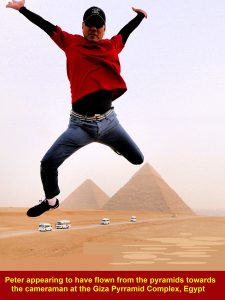
Peter Lim, a tour member, appearing to have flown like the Superman from the pyramids to the cameraman
ii, Tay appearing to have jumped off the Pyramid of Khafre like the Spiderman at the Great Giza Pyramid, Egypt
iii. Yong Zhen, the tour manager, appearing to make one jump over three pyramids
iv. Tan and wife playing an exciting “game” at the Great Giza Pyramid Complex, Egypt
Camel Ride
Before we left the Great Giza Pyramid Complex, we went for a camel ride near the place in the Sahara Desert, Egypt.
Tourists love camel ride
Tour members and tourists enjoying the camel ride in the Sahara Desert
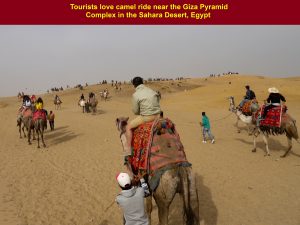
Tourists, including our tour group, love the camel ride near the Giza Pyramid Complex in the Sahara Desert, Egypt.
Writer’s wife will never forget her first camel ride near the Great Giza Pyramid Complex in Sahara Desert, Egypt.
Writer and wife enjoying the camel ride together near the Great Giza Pyramid Complex in Sahara Desert, Egypt
Cindy, a tour member, loves camel riding, too.
Visit to Khan el Khalil Bazaar in Cairo
After the visit to the Great Giza Pyramid and the camel ride, we went to a bazaar in Cairo city. Known as Khan el Khalil Bazaar, it is the largest in Egypt that has a few thousand stalls selling goods of all kinds ranging from daily necessities to silver and gold jewellery.
El Hossein Square
On arrival at the Cairo city, we had lunch first at a restaurant in El Hossein Square. This public square is surrounded by mosques, old buildings, restaurants and coffee-shops.
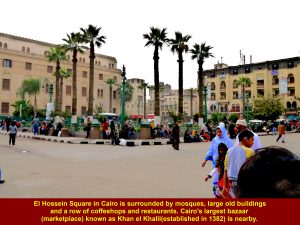
El Hossein Square is surrounded by El Hossein Mosque, a row of of coffee shops and restaurants, and large, old buildings.
El Hossein Mosque
This square has a large mosque known as el Hossein Mosque. Hence, the square takes the name of the mosque. This mosque which was built in 1154 houses some sacred items like the oldest manuscripts of Quran.
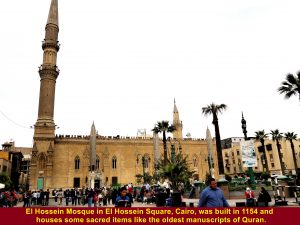
El Hossein Mosque built in 1154 in the Square houses some sacred items like the oldest manuscripts of Quran.
A row of restaurants and coffee-shops in the El Hossein Square
The Khan el Khalil Bazaar is behind this row of restaurants and coffee-shops
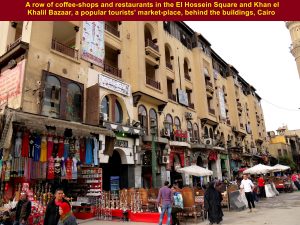
A row of coffee-shops and restaurants in the El Hossein Square and Khan el Khalili Bazaar behind the buildings
Writer, wife, brother and sister-in-law(left to right) having lunch at a restaurant, Abou Mazen Restaurant, in El Hossein Square, Cairo, on 23 Dec 2017
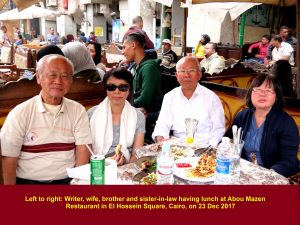
Writer, wife, brother and sister-in-law having lunch at Abou Mazen Restaurant in El Hossein Square, Cairo, on 23 Dec 2017
Delicious Lunch
We had a delicious lunch at Abou Mazen Restaurant, El Hossein Square, Cairo, Egypt
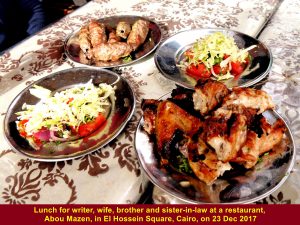
Delicious lunch for writer, wife, brother and sister-in-law at Abou Mazen Restaurant, El Hossein Square, Cairo
Egypt’s Largest Bazaar
After lunch my wife and I walked to Egypt’s largest bazaar, Khan el Khalil Bazaar, which is a few metres from the El Hossein Square and right behind the row of restaurants and coffee-shops.
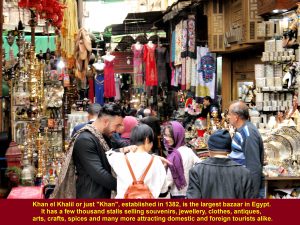
Khan el Khalil Bazaar, established in 1382 in Cairo, is the largest market-place in Egypt. It has a few thousand stalls attracting domestic and foreign tourists alike.
Over a Thousand Shops and Stalls
There are over a thousand shops and stalls at Khan el Khalil Bazaar selling goods ranging from clothes, shoes and souvenirs to silver and gold jewellery.
A busy shopping street at the bazaar, Khan el Khalil or just Khan
Street Vendors at Khan el Khalil Bazaar
Goods overflowing a street at the bazaar
Domestic and foreign visitors are spoilt for choice at the bazaar.
Writer’s wife buying T-shirts at Khan el Khalil Bazaar
Photos below show some of the things for sale at the shops of the bazaar.
Jewellery for sale
Colourful clothes for sale
Souvenirs for sale
Paintings on papyrus papers for sale
Water-pipes for smoking “shisha” for sale
“Shisha” Smoking
An Egyptian showing the writer the way he smokes “shisha”. Like smoking cigarettes, it can cause health problems as it uses tobacco, too.

An Egyptian showing the writer the way he smokes shisha. Like smoking cigarettes, smoking “shisha” can cause health problems as it uses tobacco, too.
Departure from Cairo for Home
In the late afternoon, we left the bazaar for Cairo International Airport where we would fly home on an Emirates airplane at 7.05 in the evening.
Tour Group Flying Home on an Emirates Airplane
Tour Group flying home from Cairo to Singapore via Dubai
Egypt Trip to Remember
We have spent 11 days visiting ancient historical places, boat-cruising along River Nile, flying in a hot-air balloon, sailing in a submarine in Naama Bay, visiting the largest bazaar and other unforgettable activities in Egypt. We are glad that we have enjoyed every moment of the trip.
Map showing the places we visited in Egypt from 13-23 Dec 2017
Acknowledgement
Thanks to Chan Brothers Travel Agency(Singapore) for the wonderful Egypt tour, Yong Zheng(tour manager) for taking good care of us and Khaled(Egypt tour guide) for imparting his invaluable knowledge about the historical places we visited. I must also thank all the tour members for being such good friends.
(The End of Egypt Travel)
Egypt Travel Parts I to XII
Egypt Travel Part I :Salah el Din Citadel, Muhammad Ali Mosque, Tahrir Square and Egyptian Museum
Egypt Travel Part II :Valley of the Kings, Hatshepsut Temple and Colossi of Memnon
Egypt Travel Part III :Hot Air Balloons and Karnak Temple Complex
Egypt Travel Part IV :Papyrus Paper-Making, Luxor Temple and Esna Lock
Egypt Travel Part V :Edfu Temple, Kom Ombo Temple and Galabia Party
Egypt Travel Part VI :Abu Simbel Temples and Nubian Village(Elephantine Island)
Egypt Travel Part VII :Unfinished Obelisk, Aswan High Dam and Philae Temple
Egypt Travel Part VIII:Ahmed Hamdi Tunnel, Moon Beach(Ras Sudr), and St. Catherine
Egypt Travel Part IX :Mount Sinai, Catherine’s Monastery and Sharm el Sheikh
Egypt Travel Part X :Sharm el Sheikh
Egypt Travel Part XI :Cairo Food, Saqqara Step Pyramid Complex and Memphis
Egypt Travel Part XII :Great Giza Pyramid Complex and Khan el Khalil Bazaar
Italy Travel Part I: Rome and Vatican City
Filed under: Uncategorized
Italy Travel Part I: Rome and Vatican City
Italy is a popular tourists’ destination that is rich in history and culture. She has many interesting cities where old, monumental buildings built in Gothic, Classical, Medieval, Baroque and Neoclassical architectural styles still exist.
Italy Tour of 7 Cities
Tour-Group and Tour-Manager
My wife and I joined a group of 20 Malaysians under a Golden Destinations(Malaysia) tour manager, Jenny, and travelled to Italy for a five-day land tour of 7 cities, namely Rome, Vatican City, Pisa, Verona, Florence, Venice and Milan.
Map of Italy showing Cities to be Visited
Writer and Wife
Tour-Manager, Jenny
Day 1 Thursday, 2 November 2017
Air Flight to Italy
On the first day we left KLIA(Malaysia), travelled to Hong Kong and then to Rome in Italy. The air-flight was long taking about 15 hours.
Day 2 Friday, 3 November 2917
Visiting Rome and Vatican City on Day 2
Rome Tour Guide, Christina
When we arrived in Rome, Italy, on the 2nd. day, a Polish coach-driver, Bart, brought us to some historical places in Rome and later to other cities in northern Italy for a total of 5 days.
Bart, the Coach-Driver
Map of Italy showing the location of Rome and Vatican City
Jenny, our tour-manager, led us to the historical places in Rome and they were as follows:
Monument of Victor Emmanuel II
The first place we visited was one in the centre of Rome City where we saw the massive Monument of Victor Emmanuel II(1820-1878). It was built in honour of Emmanuell II for unifying Italy in 1861 and becoming her first king. It was built by several well-known sculptors in the 1885-1925 period.
Pantheon
Then we walked to Venezia Square where a Roman temple was built in 113-125 A.D periodk. Now it is a Catholic church dedicated to “St. Mary and Martyrs”. The front of the church is supported by 12 Cornithian columns and a rotunda with a dome is behind them.
Tombs of Kings
Tombs of two Italian kings, Victor Emmanuel II(1820-1878) and Umberto I(1844-1900), are displayed in the building. The tomb of Umberto I’s wife, Margerit(1851-1926), is inside, too.
Piazza della Rotunda
Outside Pantheon is a square known as Piazza della Rotunda which has an obelisk and fountain.
Colosseum in Rome
From Pantheon we walked to a historical site where Italy’s iconic Roman amphitheatre was built. Known as Colosseum, it was built in the 72-80 A.D. period by two Roman Emperors, first Vespasian and later, Titus. Built for gladiators’ contests and public spectacles, it could accommodate 65 000 spectators.
Christina, the Colosseum Tour-Guide
At the Colosseum we met our local tour-guide, Christina, who showed us around the amphitheatre.
Fall of the Western Roman Empire
The Colosseum ceased to be used for gladiators’ contests and public spectacles in the early Medieval Period or Middle Ages(5-15th. Century) after the fall of the Western Roman Empire. Then it was used for such purposes as a cemetery, workshops and for housing.
Earthquake
In 1349, a strong earthquake damaged the southern part of the Colosseum and it was repaired later.
Colosseum in Ruin
Owing to weathering, erosion and neglect for over a 1000 years, the Colosseum is in ruin, but millions of visitors continue going to Rome to see the legacy of the Roman Empire every year.
Colosseum Decorations Were Stolen
Since the Colosseum was not used after the fall of the Western Roman Empire in the 4th. Century, marble statues and stucco decorations were all stolen; leaving the amphitheatre bare with ugly holes in the walls.
Colosseum’s Wooden Floor of Arena
The wooden floor of the Arena of the Colosseum soon rotted and was removed, exposing the underground rooms and passageways.
Arch of Constantine
Next to the Colosseum stands a triumphal arch known as Arch of Constantine. It was built in 315 A.D. to commemorate Constantine I(272-337)’s victory in the Battle of Milvian in 312 A.D.
(Arch of Triumph in Paris built in the 1806=1836 period, looks similar to this smaller Roman triumphal arch in Rome. The former was erected in honour of those who fought and died for their country in the French Revolutionary and Napoleonic wars.)
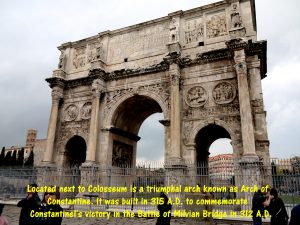
Arch of Constantine built in commemoration of Constantine I’s victory in the Battle of Milvian in 312 A.D.
Visiting Vatican City
Later, we moved on to the world’s smallest country, Vatican City, that is surrounded by the city of Rome. It has a population of about 840 and a small area of 44 hectares which is equivalent to 82 football fields.
She has the largest Catholic church in the world known as St. Peter’s Basilica that was built in the 1506-1626 period.
The church is dedicated to St. Peter(one of Jesus Christ’s apostles and the first pope) and the burial site of St. Peter. It is a popular place for pilgrimage and liturgical functions.
Rain and Long Queue
When we arrived at the church, St. Peter ‘s Basilica, it was drizzling and we had to join a long queue to enter the church. According to our tour manager, Jenny, we were lucky that we queued for about an hour before we entered the church. She had to queue for three hours the last time she brought a tour group there!
“Pieta”
When we entered the church, the first thing that caught my eyes on the right was a marble sculpture known as “Pieta”.
“Pieta” is a masterpiece created by a famous Italian sculptor, Michelangelo Buonorroti(1475-1564), from 1498 until 1499. It depicts Virgin Mary holding her dead son, Jesus Christ, on her lap after his crucifixion.
More sculptures, monuments, paintings and statues of previous popes, founders of religious orders, etc. can be seen in the church.
Other Basilicas
On the floor of the nave are markers showing the comparative sizes of other basilicas in other places.
The Holy Door
There is a special door known as “The Holy Door” made of bronze in the northernmost entrance of St. Peter’s Basilica in Vatican City. It depicts the life of Jesus Christ.
The door is cemented shut and only opened for Jubilee Years of the church. The Catholics believe that if they go through the door during the Jubilee Years, they may be granted the plenary indulgences.
Change of Guards at St. Peter’s Basilica
Coming out of the church at 5 p.m. I was fortunate to watch the change of the Swiss guards at the entrance adjacent to the church. The ceremony lasted for 5 minutes.
The guards are Swiss citizens. Their duty is to protect the pope and the church. They wear a colourful uniform which has vertical blue, red, orange and yellow stripes.
Victoria Terma Hotel
In the evening we left the church, went for dinner and retired to our rooms at Victoria Terma Hotel that is a few kilometres from Rome City.
Italy Travel Part I: Rome and Vatican City
Italy Travel Part II : Rome(continued)
Italy Travel Part III: Pisa and Florence

